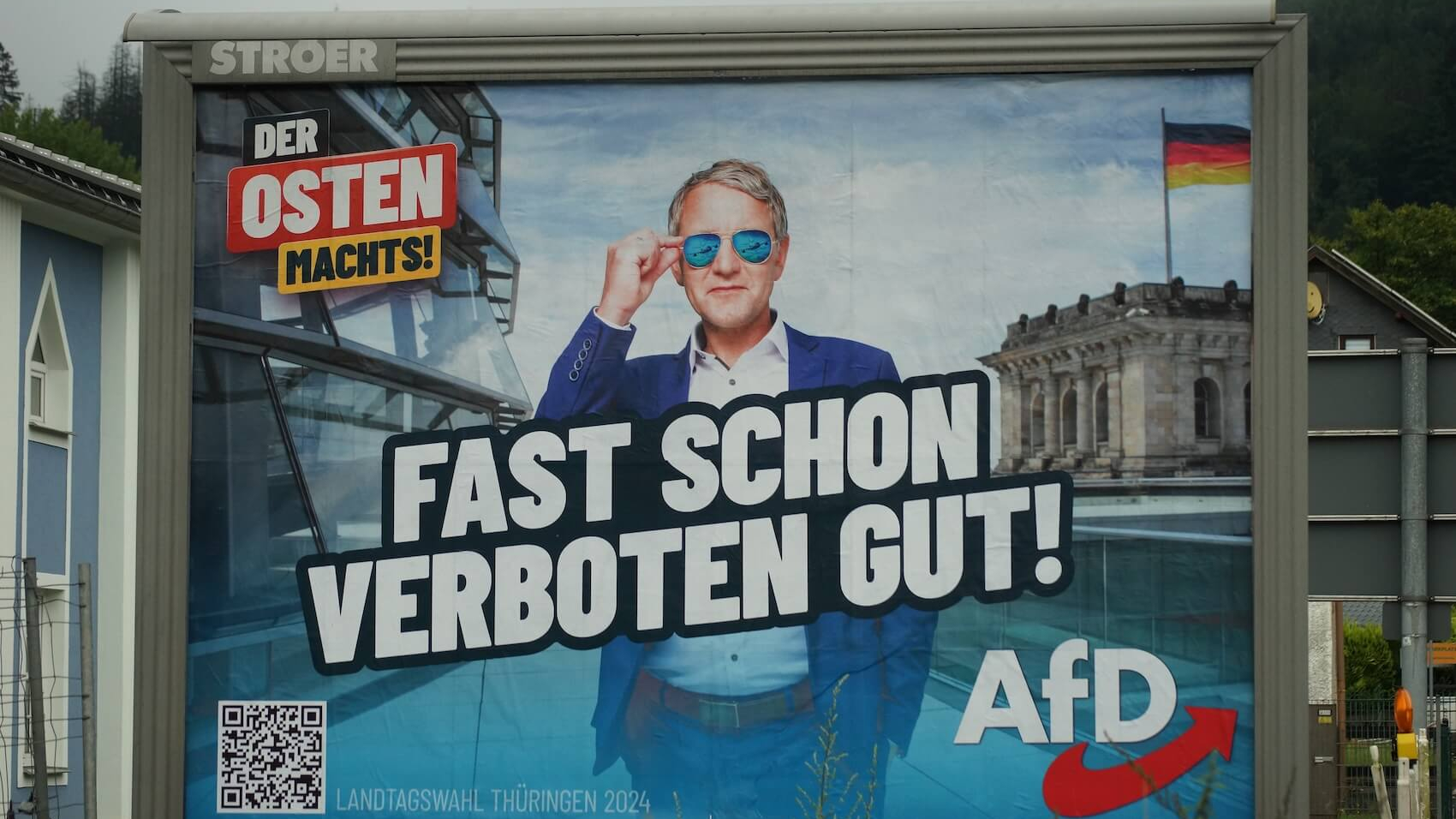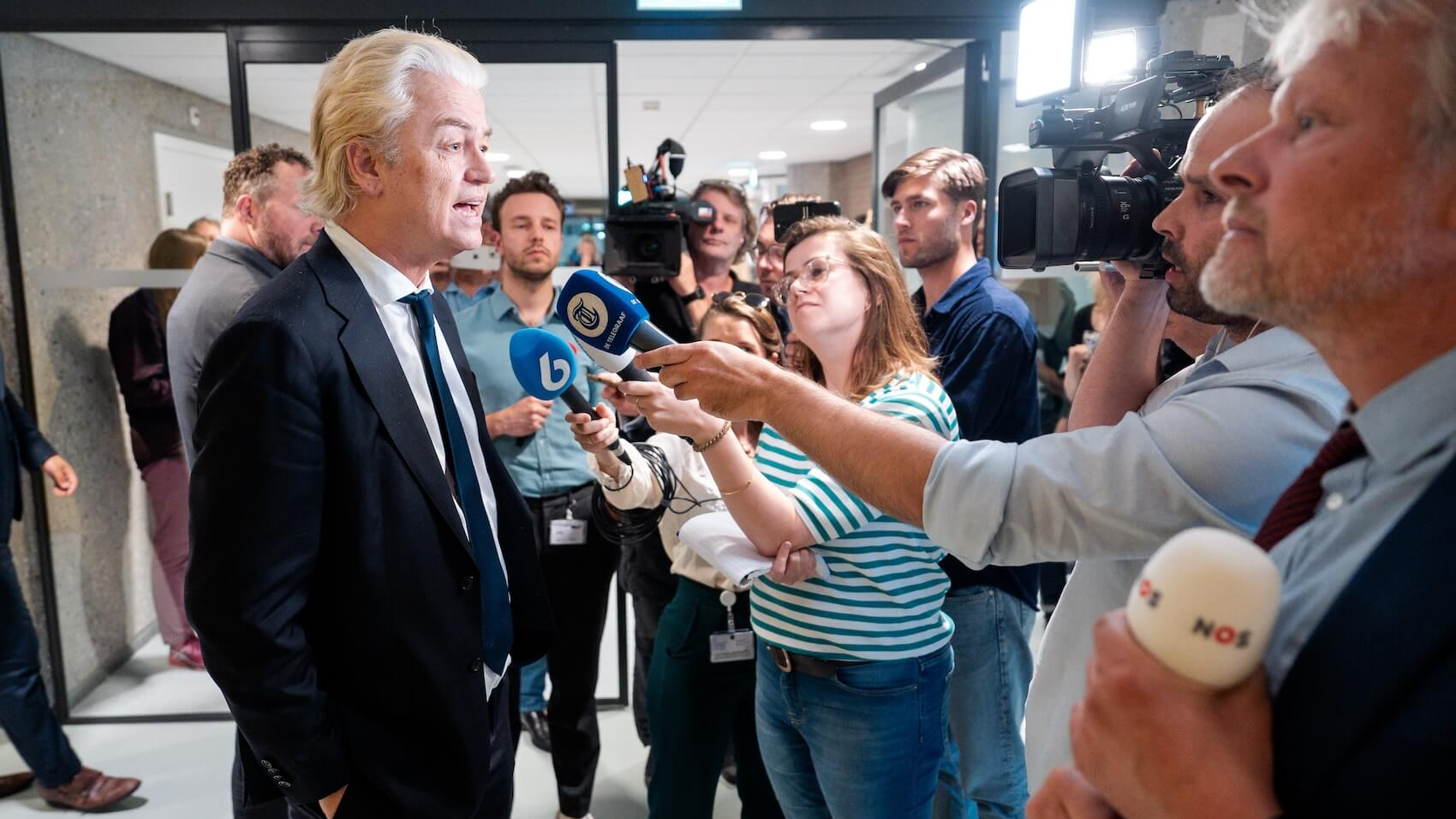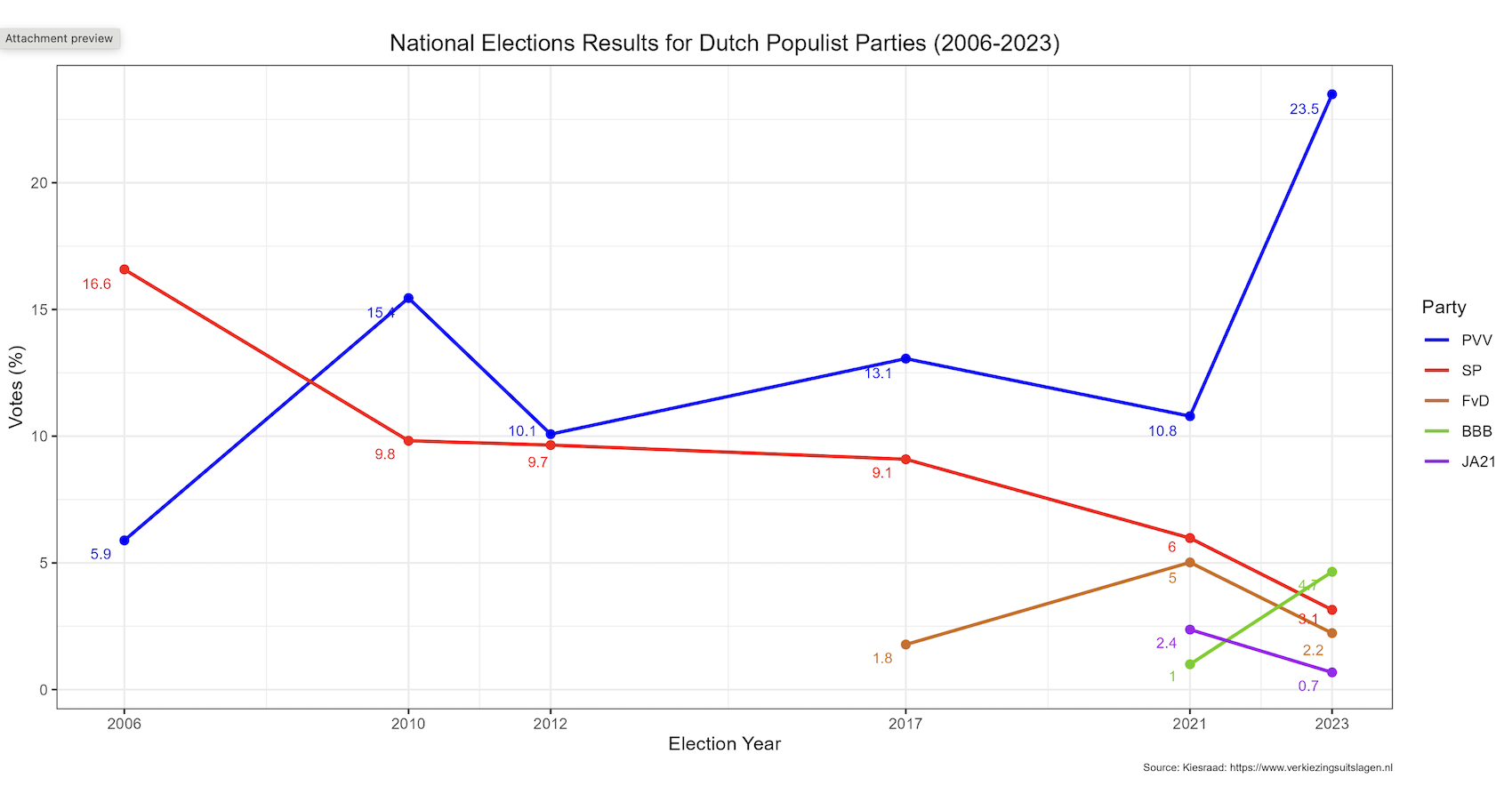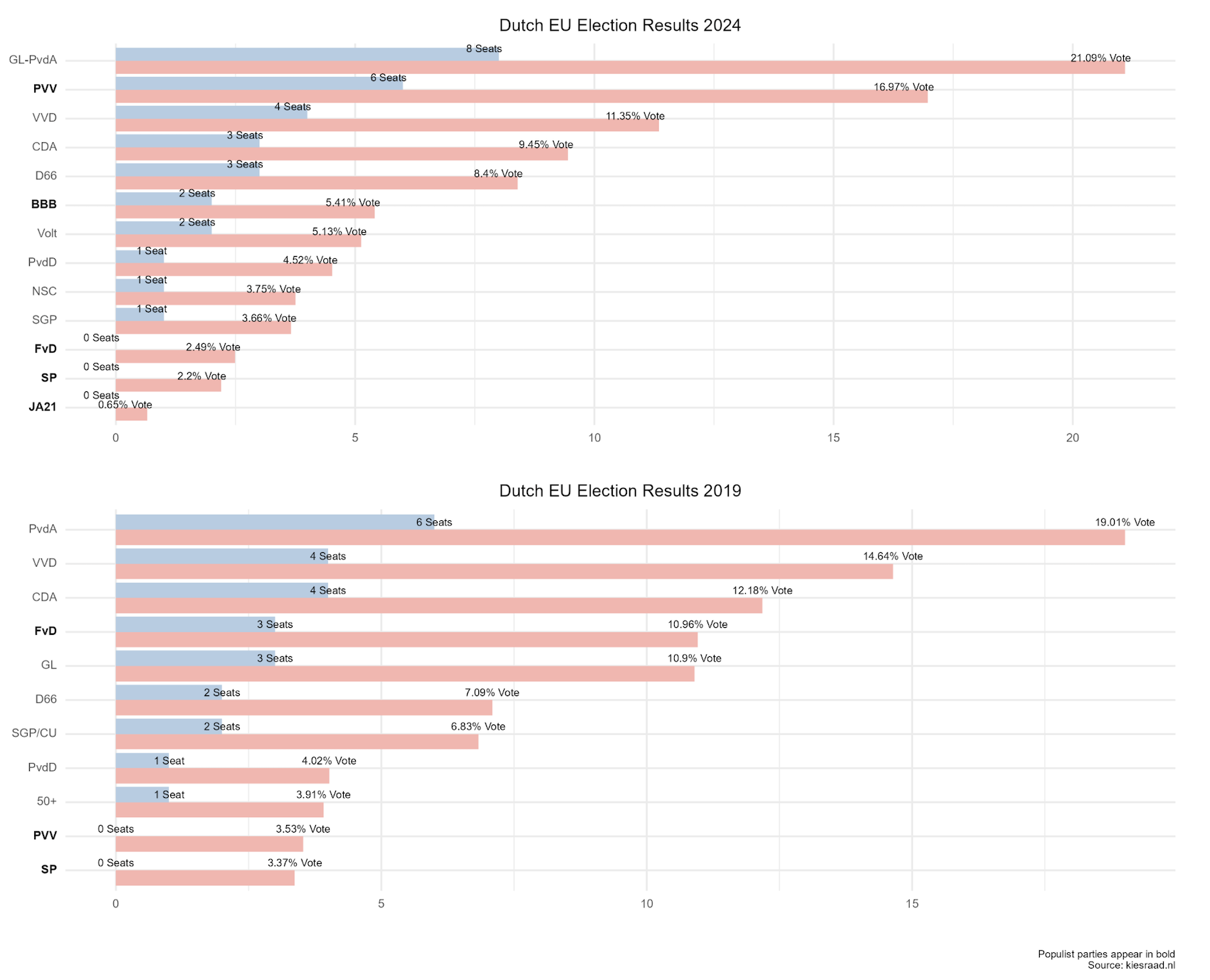Please cite as:
van Haute, Emilie. (2024). “Populist Radical Parties in Belgium and the 2024 European Elections.” In: 2024 EP Elections under the Shadow of Rising Populism. (eds). Gilles Ivaldi and Emilia Zankina. European Center for Populism Studies (ECPS. October 22, 2024. https://doi.org/10.55271/rp0062
DOWNLOAD REPORT ON BELGIUM
Abstract
In 2024 elections in Belgium were concurrently held for the European, federal and regional levels. For that reason, the European elections were clearly second-order elections. As the main opposition parties at the federal level, populist radical parties of the right (Vlaams Belang, VB) and the left (the Workers’ Party of Belgium, PTB–PVDA) approached the 2024 elections in a strong position. They were portrayed as clear favourites in the polls and the media. From 2019 to 2024 they managed to set the agenda on their issues: migration and law and order for the VB, socioeconomic issues and civil liberties and rights for the PTB–PVDA. Both parties came out of the elections with more votes and seats. Part of the reason for this success is that their program matched with voters’ priorities. Their populist, anti-elite rhetoric also permeated public opinion. Yet they were perceived as having underperformed electorally. Moreover, because they were not politically indispensable, they were quickly sidelined. At the European level, the VB and the PTB–PVDA will likely continue directly pushing their respective populist, Eurosceptic and radical agendas. They are also likely to have a real indirect contamination effect through mainstream parties and public opinion integrating part of their programmatic positions and priorities.
Keywords: Belgium; radical parties; populism; voting behaviour; European elections
By Emilie van Haute* (Department of Political Science, Université libre de Bruxelles (ULB), Brussels, Belgium)
Introduction
The 2024 European elections in Belgium appeared distinctly like the ‘mother of all elections’. Voters were called to cast ballots concurrently in three separate elections (European, federal and regional) held on the same day. Additionally, it had been five years since Belgian voters had faced a single election. Consequently, it was also a test of the balance of power between the numerous parties that form the two separate party systems operating in the country.
Belgium has a highly fragmented multiparty system. Since the split of traditional party families along the linguistic divide, Belgium has been characterized by two party systems operating separately (Table 1): Flemish parties compete in Flanders (the north of the country), whereas Francophone parties compete in Wallonia (in the south). Parties only compete together in Brussels.
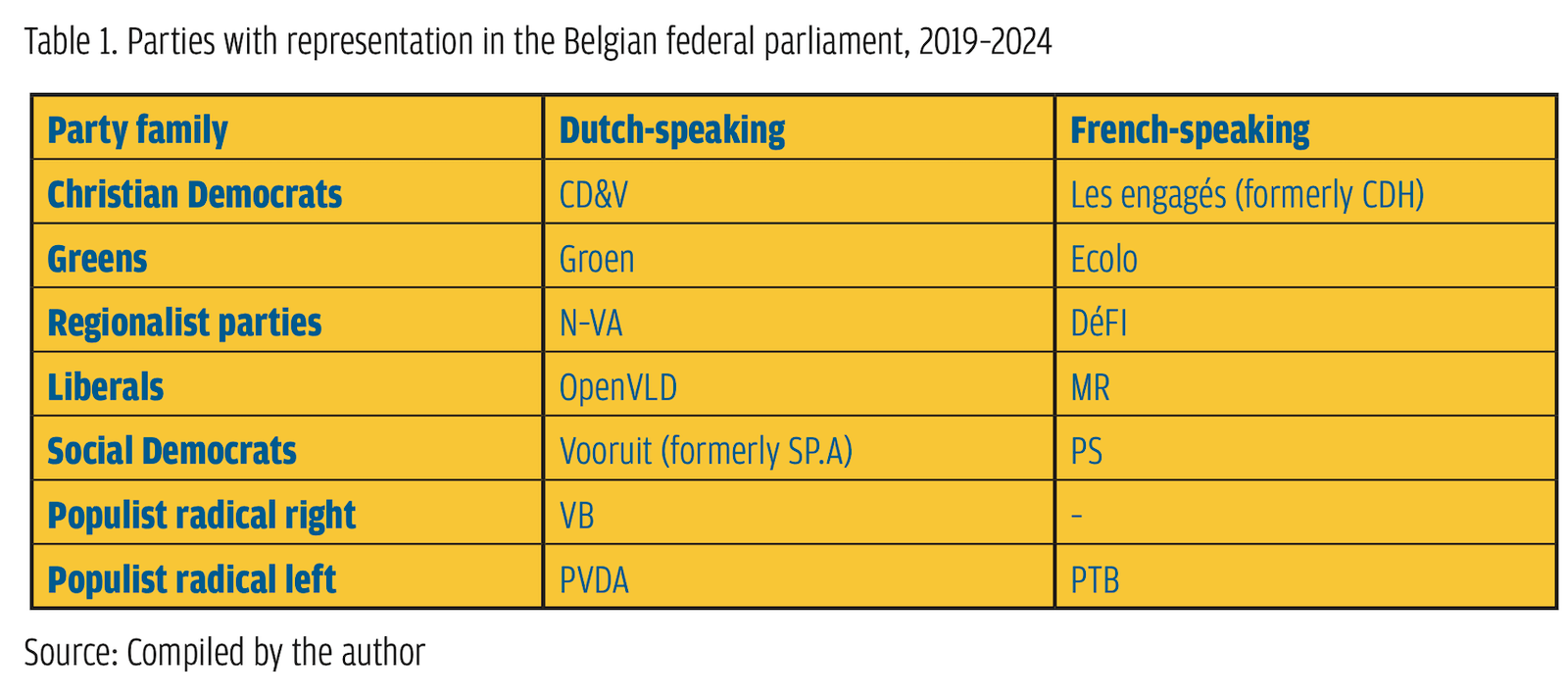 Among these parties, two are clear cases of populist radical parties based on the PopuList categorization (https://popu-list.org): the radical-left Workers’ Party (Parti du Travail de Belgique–Partij van de arbeid, PTB–PVDA), the only relevant national party in Belgium (Delwit, 2014; 2022), and the radical-right Flemish Interest (Vlaams Belang, VB), a party that competes only in Flanders and in Brussels (van Haute & Pauwels, 2016). On the French-speaking side, the populist radical-right parties have always had a hard time anchoring themselves structurally in the political landscape (De Jonge, 2021b; Delwit & van Haute, 2021). The present chapter therefore analyses the electoral performance of the PTB–PVDA and the VB at the 2024 EP elections.
Among these parties, two are clear cases of populist radical parties based on the PopuList categorization (https://popu-list.org): the radical-left Workers’ Party (Parti du Travail de Belgique–Partij van de arbeid, PTB–PVDA), the only relevant national party in Belgium (Delwit, 2014; 2022), and the radical-right Flemish Interest (Vlaams Belang, VB), a party that competes only in Flanders and in Brussels (van Haute & Pauwels, 2016). On the French-speaking side, the populist radical-right parties have always had a hard time anchoring themselves structurally in the political landscape (De Jonge, 2021b; Delwit & van Haute, 2021). The present chapter therefore analyses the electoral performance of the PTB–PVDA and the VB at the 2024 EP elections.
Background
After a series of electoral setbacks after 2007 caused by the emergence of an alternative Flemish nationalist vote with the N–VA and internal tensions around the dominance of the party elite from Antwerp (van Haute & Pauwels, 2016), the populist radical-right VB returned to success at the 2019 European, federal and regional elections. The VB won a substantial number of seats: from 3 seats in the House of Representatives at the federal level in 2014 to 18 seats in 2019. More generally, 2019 saw a substantial shift in party preferences towards radical populist parties (Goovaerts et al., 2020) since the PTB–PVDA also won a significant number of seats (from 2 in 2014 to 12 seats in 2019). These results contributed to a fragmented and polarized political landscape, with VB gaining grounds in Flanders and PTB–PVDA winning in Walloon constituencies. These trends also characterized the concurrent European elections (Figures 1 and 2).
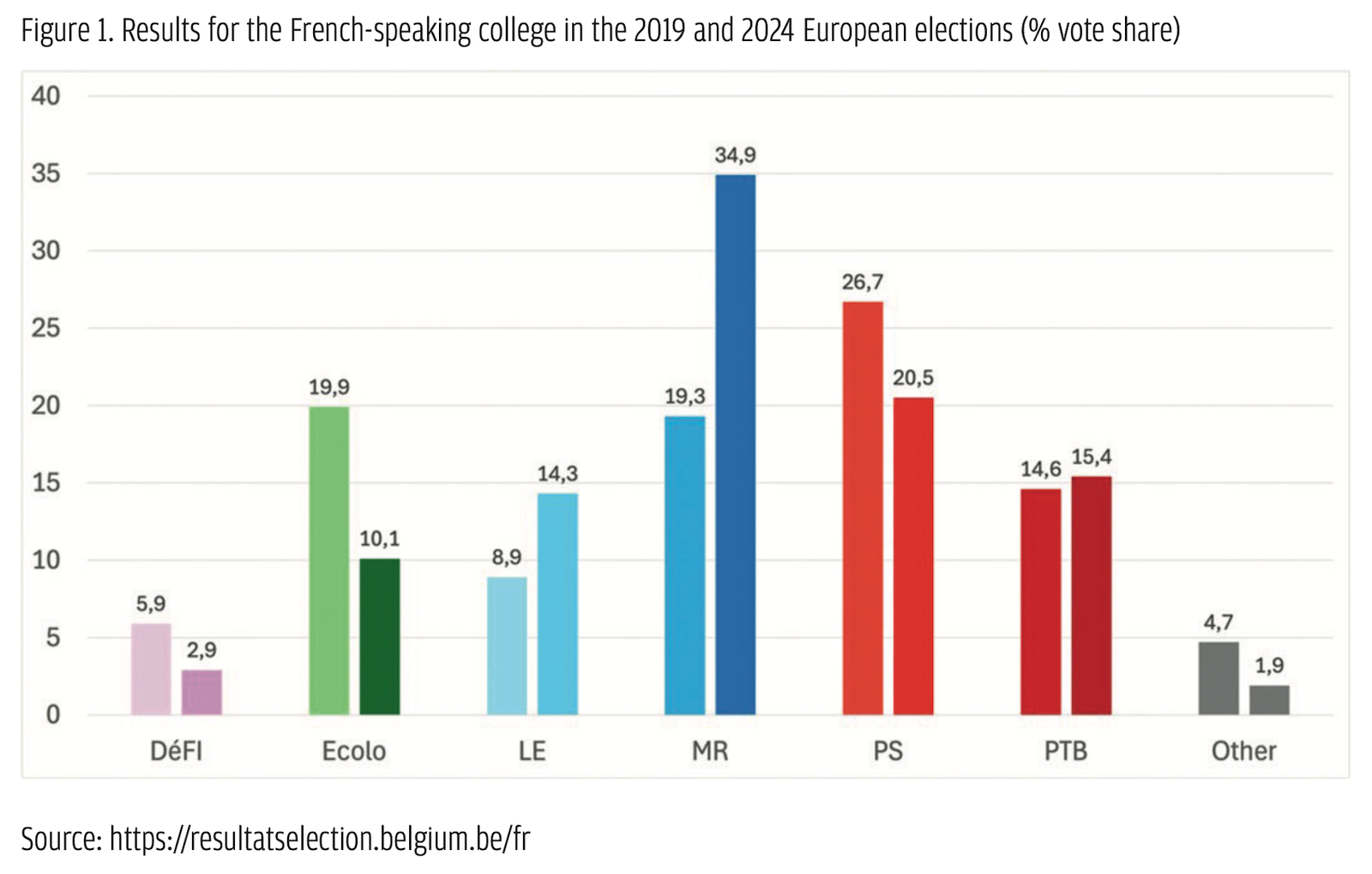
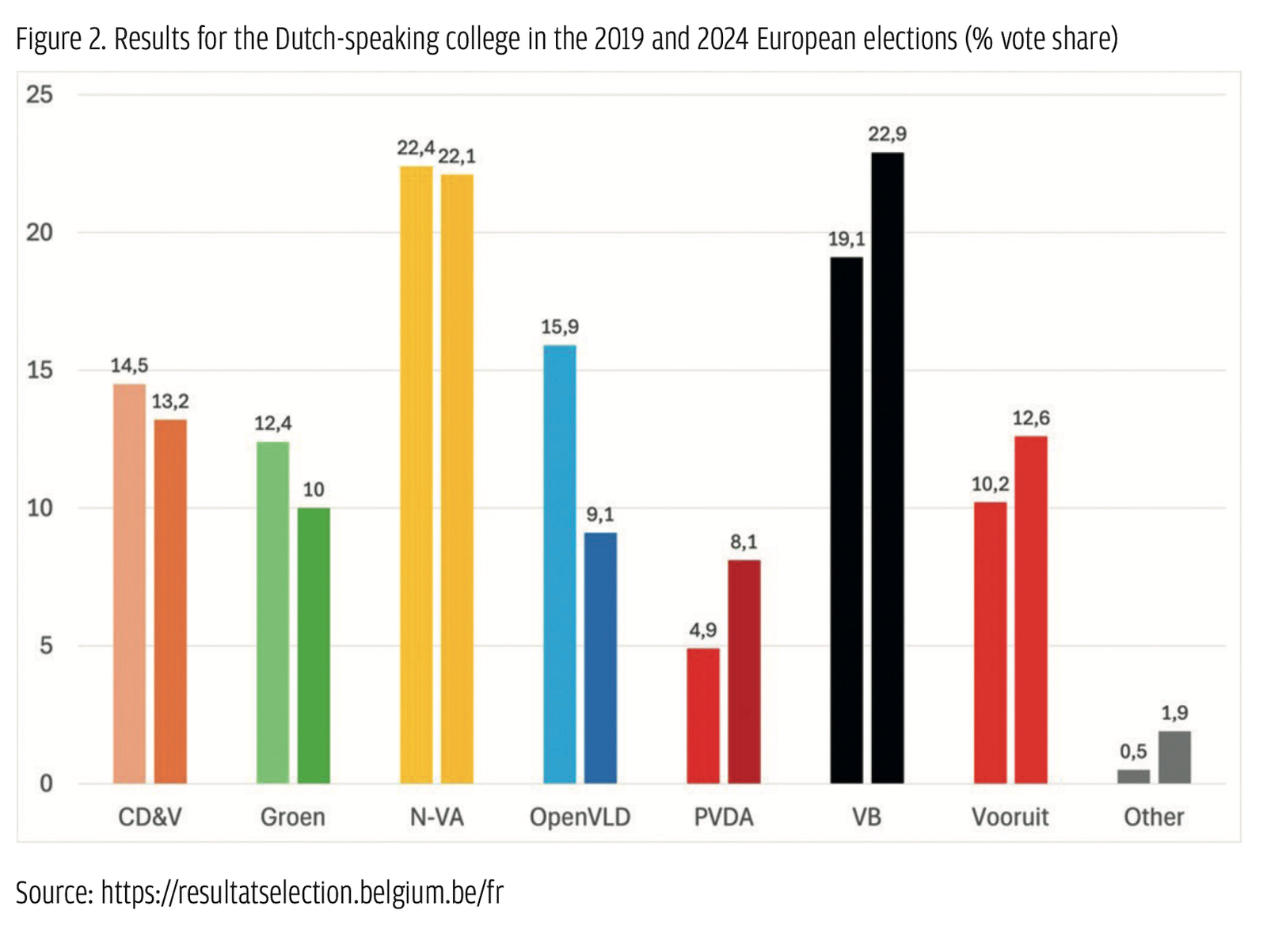 The profile of VB and PTB–PVDA voters in 2019 presented similarities. Data from the 2019 Belgian panel survey (Michel et al., 2024) show that both parties attracted a younger, more male voter group with lower levels of education and a protest component, and displaying lower levels of trust and satisfaction with the government, but also higher levels of anger (Gallina et al., 2020; Jacobs et al., 2024). Populist radical parties thus clearly capitalized on voters seeking an alternative. But they also attracted issue-based voting on their core respective issues (Goovaerts et al., 2020; Walgrave et al., 2020).
The profile of VB and PTB–PVDA voters in 2019 presented similarities. Data from the 2019 Belgian panel survey (Michel et al., 2024) show that both parties attracted a younger, more male voter group with lower levels of education and a protest component, and displaying lower levels of trust and satisfaction with the government, but also higher levels of anger (Gallina et al., 2020; Jacobs et al., 2024). Populist radical parties thus clearly capitalized on voters seeking an alternative. But they also attracted issue-based voting on their core respective issues (Goovaerts et al., 2020; Walgrave et al., 2020).
VB voters position themselves furthest to the right on the left–right axis and PTB–PVDA furthest to the left. For the PTB–PVDA, this positioning reflects the salience of socioeconomic issues for its voters, whereas for the VB, cultural issues are most salient (Pilet et al., 2020). What explains this difference in the success of populist radical parties across the linguistic divide is not so much the differences in attitudes between French- and Dutch-speaking voters. The average position on socioeconomic and migration issues, for instance, are very similar (Walgrave et al., 2019).
Rather, it is the structure of the party system and the salience of issues that make a difference. The weakness of the radical-right party organizations in French-speaking Belgium is patent (Close & Ognibene, 2021); in contrast to the VB, such parties lack local anchorage, links with civil society organizations and leadership. Partly due to the cordon sanitaire in the French-speaking media (De Jonge, 2021a), radical-right parties are not able to push their issues on top of the political agenda. While migration was the top priority among voters in Flanders in 2019, it only ranked fifth in Wallonia, where socioeconomic issues dominated (Walgrave et al., 2019).
The 2019–2024 legislature was particularly difficult at the federal level. The polarized results of 2019 put centrifugal pressures on parties in the two political sub-systems. Despite the extended period of minority caretaker government after the N–VA withdrew from the federal government in December 2018, the negotiations to form a new government after the 2019 elections quickly stalled. The position of the two main parties on each side of the linguistic border, the N-VA and the PS, proved irreconcilable as they were both pushed by the pressure of their respective radical challengers, the VB and the PTB. In March 2020, the COVID-19 crisis was an accelerator, and the caretaker government was given six months of full power as a minority government. In October 2020, sixteen months after the elections, a full government was finally formed, composed of seven parties: the two liberal parties (OpenVLD and MR), the two socialist parties (Vooruit and PS), the two green parties (Groen and Ecolo), and the Dutch-speaking Christian Democrats (CD&V). The new government had to deal with COVID-19 and its aftermath, as well as Russia’s February 2022 invasion of Ukraine, the consequent influx of refugees, the energy crisis and high inflation. With seven parties around the table, it was very difficult to agree on major reforms.
The challenge made it easy for opposition parties to capitalize on the weakness of the federal government. On the Dutch-speaking side, the main opposition came from the VB, as the N-VA was leading the Flemish regional government, which was also facing difficulties. On the French-speaking side, the main opposition came from the PTB and Les Engagés.
An analysis of the communication of all 13 parties represented in the federal parliament and their leaders on Twitter (now X) between 1 January 2022 and 31 March 2023 (N=16,330 tweets) reveals that populist radical parties were much more active on social media than mainstream parties (Close et al., 2023; see also Delwit & van Haute, 2021).
The content of this communication provides insights into the saliency and ownership of issues. Overall, the public debate in Flanders and French-speaking Belgium revolved around different issues. Flanders saw more focus on migration, law and order issues (crime, justice), and finance, whereas in French-speaking Belgium, the focus was more on energy, civil rights and liberties, and work (Close et al., 2023). Despite the international context, European issues and foreign affairs were not dominant.
This agenda was particularly favourable to the populist radical parties. Close et al. (2023) have shown that the VB positions itself clearly on the most salient issues in Flanders. They come up first in terms of mentions of migration, law and order (including terrorism), but also lifestyle and religion. Interestingly, the party also comes second on EU issues after the Dutch-speaking Liberals (who held the federal prime ministership) and on animal welfare. They come up third in agriculture.
The PTB also position itself also on the most salient issues in Wallonia (Close et al., 2023), especially civil rights and liberties. The difference in discourse between the two branches of the party is striking in that regard. The results also show that the party avoids any mention of migration issues. Conversely, it clearly owns socioeconomic issues. The party ranks first in terms of mentions of employment, work, pensions, finances, and disasters (on the French-speaking side, linked to the floods of 2021). It ranks second on economy and foreign affairs.
Populist radical parties thus approached the 2024 elections in a strong position. They occupied the position of outsiders and alternative vote to an unpopular federal government. They owned the most salient issues in their respective polarized political landscapes. In Flanders, the VB was systematically polling first after autumn 2022 (VRT, 2023), and the PVDA was for the first time also showing anchorage in Flanders. In Wallonia, the PTB was polling third from March 2020, and the gap with the first two parties, the Socialists and the Liberals, was closing in after March 2022.
An electoral victory portrayed as a political defeat
The European elections in Belgium were marked by a change in the electoral rules, allowing 16- and 17-year-olds to vote. After a controversy, voting was also made compulsory for this segment of the electorate. More generally, with no elections held in Belgium since 2019, the 2024 electorate comprised more than a million first-time voters, including 268,000 voters aged 16–17 for the EP elections, which had the potential to weigh on the results.
Radical parties performed extremely well electorally on 9 June (see Figures 1 and 2). At the European level, the VB ranked first in the Dutch-speaking group with 22.9% of the votes, representing an increase of almost 4 percentage points. Given the low number of seats allocated to the Dutch-speaking group (13 out of 22 for Belgium), the party failed to gain an additional seat and therefore tied with N-VA. The progress of the PTB–PVDA was asymmetrical. On the Dutch-speaking side, the party almost doubled its vote share, from 4.9% in 2019 to 8.1% in 2024. It allowed the party to get its first seat in the European Parliament in the Dutch-speaking group. On the French-speaking side, the PTB also confirmed progress. With 15.4% of the votes in the French-speaking group, it gained about 1 percentage point and climbed from the fourth (2019) to the third position. Again, given the low number of seats allocated (8), this symbolic progress did not see the party gain any additional representatives, again taking just one seat in the EP in the French-speaking group.
However, these good electoral performances were overshadowed by what happened at the federal and regional levels. On the Dutch-speaking side, even if the VB progressed and the N-VA lost votes and seats, the latter managed to remain the first party at these levels. The VB underperformed compared to expectations based on the pre-election polling, possibly due to the large number of undecided voters, which makes accurate polling difficult (Pilet et al., 2024). Also, politically, Bart De Wever, leader of the N-VA, clearly closed the door to the VB a couple of days before the elections and encouraged voters to vote for the N-VA, saying that a vote for the VB would be a lost vote. This call for strategic voting seems to have paid off, as N-VA remained the first party at the regional and federal levels but not at the European level, where voters had a lower incentive for strategic voting.
Another element that may have weighed is the performance of De Wever in a new popular TV show, ‘Het conclaaf’ (‘The Conclave’), where he spent a weekend locked away with the VB leader Tom Van Grieken. De Wever clearly dominated the exchanges. Finally, together, N–VA and VB did not come out of the elections with a majority of seats in the Flemish parliament, which de facto excluded this only coalition option. Vlaams Belang was thus quickly portrayed as the underperformer; N-VA managed to frame these results as a victory, and VB was excluded from the negotiations for government formation at the regional and federal levels. The PTB–PVDA also gained votes and seats. At the federal level they progressed in Flanders (from three seats in 2019 to six in 2024, now getting at least one seat in each constituency) and in Brussels (from two to three seats). In Brussels, the PTB mainly gained voters from the socialist party PS and came top among first-time voters (Biesemans et al., 2024). However, the party lost seats in the Walloon constituencies (one at the federal level, two at the regional level). It did not manage to steal as many former PS voters, and it did not convince the first-time voters who turned more massively to the Liberals (MR) and the former Christian Democrats (LE) (Close et al., 2024). As for the VB, the party underperformed compared to what the polls had created regarding expectations, which overshadowed its other victories. The leadership of right-wing parties in the negotiations for government formation in Brussels and Wallonia also meant that the party was directly excluded from the equation.
A program and communication in tune with voters’ priorities
Vlaams Belang presented a classic populist radical-right manifesto for the 2024 elections. Titled ‘Flanders Back to Us’ (VB, 2024), the program puts ethnonationalism first, advocating for Flanders’ independence from Belgium, power to the people, a stop to immigration and a strong take on law and order. Socioeconomic, fiscal and cultural issues are framed in ethnonationalistic terms. In a classic welfare chauvinist approach, national preference is portrayed as the solution to poverty and high housing prices and better health care services; independence is painted as the solution to fiscal and budgetary issues, as the party denounces fiscal transfers to French-speaking Belgium and asks for the return of ‘Flemish money in Flemish hands’ (VB, 2024: 10).
Since elections were held concurrently for three levels, more local issues were covered first, while Europe was discussed in detail only on the last two pages of the VB manifesto (VB, 2024: 96–97). The party uses the ‘taking back control’ tagline and denounces EU leaders as ‘extreme’ (and overly bureaucratic/technocratic), hallmarks of a populist radical-right platform. The party opposes further enlargement and positions itself against EU interference in the national politics of illiberal democracies (e.g., Hungary), as well as EU policies on climate, agriculture and migration. The party’s list of specific proposals includes stifling the European Parliament, reducing Belgium’s budget contribution, negotiating a package of opt-outs from certain EU policies and legislation, defending Western values and promoting the subsidiarity principle and member states’ sovereignty. Interestingly, the manifesto avoids concrete topics related to foreign affairs, such as the Russia–Ukraine War and the war in Gaza.
PTB–PVDA also presented a classic populist radical-left program for the 2024 elections. Titled ‘The Choice to Break Away’ (PTB, 2024), the program puts socioeconomic issues first, advocating for fiscal justice, more social policies and purchasing power for households, better jobs, the right to healthcare, the end of political privileges, and a social climate policy. Highly active on university campuses, the party also tailored its message to young people, which was also likely driven by an interest in mobilizing first-time voters. Similarly, the party takes a notably progressive position on rights and liberties, especially racial discrimination, feminism and LGBTQ+ issues.
The concurrent elections also blurred the VB’s specific positions regarding the EU. The party developed a separate program for the European elections, which did not contribute to making it visible. This program reflected the VB’s populist orientation, with an explicit equation of Europe with a distant class of wealthy and privileged elites. Nevertheless, while the VB mobilizes cultural values and identities to underpin its populist rhetoric, the PTB–PVDA mobilizes a socioeconomic discourse that denounces a capitalist Europe imposing austerity on the poor through nondemocratic rules. The party takes a clear stance against austerity, privileges, inequalities, poverty, punitive environmental taxes, social dumping and the logic of profit and the market. It advocates addressing the root causes of migration, such as poverty in the Global South. Regarding external affairs, the party justify its nonalignment and rejection of NATO in terms of a commitment to striving for peace. On the Israel–Hamas war, it takes a clear position in favour of Palestine, denouncing acts of genocide as against international law and human rights.
The parties’ programs were heavily relayed online. Vlaams Belang is the absolute leader in online communication in Belgium. The party spent €1.5 million during the four months preceding the elections (Ryckmans, 2024). PVDA ranked fourth, spending €708,933. While the PTB had been very present during the legislature, it took a step back during the campaign.
The content of their respective communication reveals the saliency of issues they own (Figure 3). The VB clearly made migration the salient issue in its communication during the campaign. More than a quarter of its communication on X is on this issue. The gap with other parties is massive. The party also over-communicated on crime but to a lesser extent. The PTB–PVDA clearly stands out with its focus on finance, the economy, pensions, work and all socioeconomic issues. Europe is not central to these parties; they mention it less than other parties.
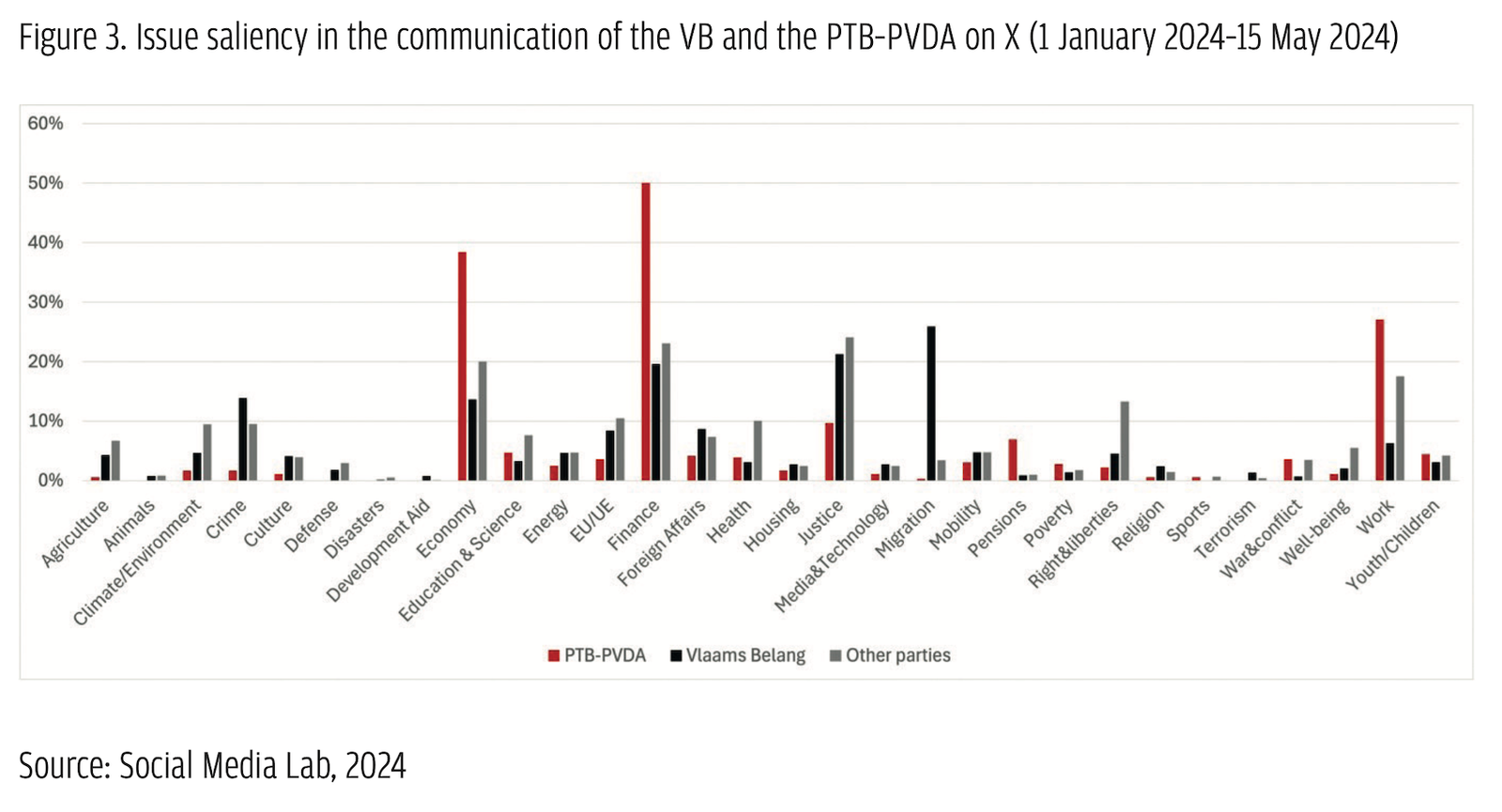 While the content reveals the ideological focus of these parties, the tone of their communication connects to their populist core. Both parties heavily rely on attacks as a mode of communication. Previous studies have shown that personal or programmatic attacks represent 26.5% of the total communication of the VB on X (first party in Belgium) and 25% for the PTB–PVDA (Close et al., 2023).
While the content reveals the ideological focus of these parties, the tone of their communication connects to their populist core. Both parties heavily rely on attacks as a mode of communication. Previous studies have shown that personal or programmatic attacks represent 26.5% of the total communication of the VB on X (first party in Belgium) and 25% for the PTB–PVDA (Close et al., 2023).
These programmatic priorities match voters’ priorities. The 2024 Belgian voter panel survey asked voters an open-ended question: ‘What is the most important issue in Belgium at the moment?’ The question was asked in wave 2 of the survey during the campaign. Results show that, in Flanders, three issues stand out: budget and finances, as well as migration and political representation, a category that refers to trust, competence, extremism, and populism (Table 2). These issues match populist radical-right demands. In Brussels and Wallonia too, migration and political representation rank high, together with the economy. Crime and Justice, Employment and institutional reforms form a second block of priorities. These priorities match populist demands towards a change in political elites and institutions, as well as the socioeconomic agenda of the radical left. The populist, anti-elite rhetoric of the two parties also permeated public opinion.

Conclusion
The 2024 elections in Belgium saw voters casting ballots for three separate levels: European, federal and regional. In this context, the EU elections were clearly second-order elections. As main opposition parties at the federal level, populist radical parties of the right (VB) and the left (PTB–PVDA) approached the 2024 elections in a strong position. They were portrayed as clear favourites in the polls and the media. During 2019–2024 they managed to set the agenda on their issues, among other things, via a robust online presence.
Both parties came out of the elections with more votes and seats. Part of this success is because their programs matched voters’ priorities. Yet they were perceived as having underperformed. And because they were not politically indispensable, they were quickly sidelined from negotiations at the regional and federal levels. At the European level, the Belgian delegation is limited, and the fragmentation of the party systems leaves the VB and the PTB–PVDA with a very limited number of seats to weigh in on policies. Nevertheless, they are expected to continue pushing their respective populist, Eurosceptic and radical agendas. As has been the case at the national level in Belgium, their programmatic positions and priorities have contaminated public opinion and the mainstream parties, which feel pressured by their success, something that is a significant source of concern.
(*) Emilie van Haute is Francqui Research Professor at SciencePo ULB (Centre d’étude de la vie politique – Cevipol). Her research interests focus on political parties, political participation and representation, elections and democracy. Her work has appeared in numerous international journals, including Comparative European Politics, the European Journal for Political Research, the Journal of Elections, Party Politics, Public Opinion and Parties, Representation and West European Politics. She is the co-editor of Acta Politica. Email: emilie.van.haute@ulb.be
References
2024 Belgian voter panel survey (2024). https://notlikeus.be.
Biesemans, R., Delwit, P., Vandeleene, A., & van Haute, E. (2024). Les dynamiques de vote à Bruxelles le 9 juin 2024. Premiers éléments. Note du Centre d’étude de la vie politique. https://cevipol.phisoc.ulb.be/fr/les-dynamiques-du-vote-a-bruxelles-le-9-juin-2024-premiers-elements
Close, C., & Ognibene, M. (2021). Les droites radicales en Belgique francophone. In P. Delwit & E. van Haute (eds.), Les partis politique en Belgique. Brussels : Éditions de l’Université de Bruxelles, 4th edition.
Close, C., Delwit, P., Vandeleene, A., & van Haute, E. (2024). Les dynamiques du vote en Wallonie le 9 juin 2024. Premiers éléments. Note du Centre d’étude de la vie politique. https://cevipol.phisoc.ulb.be/fr/les-dynamiques-du-vote-en-wallonie-le-9-juin-2024-premiers-elements
Close, C., Kins, L., Kumar, T., & Jacobs, L. (2023). Les partis politiques et leurs president.e.s sur Twitter : quelles tendances un an avant l’élection de 2024?, Social Media Lab @ULB.
Delwit, P. (2014). PTB. Nouvelle gauche, vieille recette. Liège: Luc Pire.
Delwit, P. (2022). The Labor Party of Belgium (PTB–PVDA): A Modern Radical Left Party?, Frontiers in Political Science, 4. doi.org/10.3389/fpos.2022.862949
Delwit P., & van Haute, E. (eds.) (2021). Les partis politique en Belgique. Brussels : Éditions de l’Université de Bruxelles, 4th edition.
De Jonge, L. (2021a). The Curious Case of Belgium: Why is There No Right-Wing Populism in Wallonia? Government and Opposition, 56(4), 598–614. doi:10.1017/gov.2020.8
De Jonge, L. (2021b). The Success and Failure of Right-Wing Populist Parties in the Benelux Countries. London: Routledge.
Gallina, M., Baudewyns, P., & Lefevere, J. (2020). Political Sophistication and Populist Party Support. The Case of PTB–PVDA and VB in the 2019 Belgian Elections. Politics of the Low Countries, 2(3), 265–288. doi:10.5553/PLC/258999292020002003003
Goovaerts, I., Kern, A., van Haute, E., & Marien, S. (2020). Drivers of Support for the Populist Radical Left and Populist Radical Right in Belgium. Politics of the Low Countries, 2(3), 228–264. 10.5553/PLC/258999292020002003002
Jacobs, L., Close, C., & Pilet, J.-B. (2024). The angry voter? The role of emotions in voting for the radical left and right at the 2019 Belgian elections. International Political Science Review, Online First. doi.org/10.1177/0192512123122452
Michel, E., Feitosa, F., Lefevere, J., Pilet, J.-B., van Erkel, P., & van Haute, E. (2024). Studying Dimensions of Representation: Introducing the Belgian RepResent Panel (2019–2021). European Political Science, 23, 199–217. doi.org/10.1057/s41304-023-00430-z
Pilet, J., Lefevere, J., Baudewyns, P., & Eck, B. (2024). Analyse de l’enquête du project NotLikeUs: Les électeurs indécis.
PTB (2024). Programme européen. https://www.ptb.be/programme-europeen
Ryckmans, G. (2024). Plus de 7,4 millions d’euros dépensés sur les réseaux sociaux par les partis politiques lors de la campagne, une stratégie payante?’, RTBF Décrypte, 23 juin 2024.
Social Media Lab (2024). Database of parties and party leaders posts on X (01/01/2024 – 15/05/2024). Social Media Lab @ULB.
Van Erkel, P., Lefevere, J., Walgrave, S., Jennart, I., Kern, A., Marien, S., & Baudewyns, P. (2020). Des transferts de voix avant ou pendant la campagne? Une étude sur les transferts électoraux lors des élections 2019 en Belgique. In J.-B. Pilet, P. Baudewyns, K. Deschouwer, A. Kern, & J. Lefevere (Eds.), Les Belges haussent leur voix (pp.29–58). PUL.
Van Haute, E., & Pauwels, T. (2016). The Vlaams Belang: Party Organisation and Party Dynamics. In R. Heinisch, O. Mazzoleni (Eds.), Understanding Populist Party Organisation. The Radical Right in Western Europe (pp.49–77). Palgrave.
Vlaams Belang (2024). Vlaanderen weer van ons. Verkiezingsprogramma.
VRT (2023). Sondage en Flandre : Vlaams Belang reste le plus grand parti, Vooruit gagne plus de terrain, le PVDA monte à la 4ème place, https://www.vrt.be/vrtnws/fr/2023/
05/13/sondage-en-flandre-vlaams-belang-reste-le-plus-grand-parti-vo/
Walgrave, S., et al. (2019). Vlamingen and Walen stemden voor verschillende partijen maar verschillen minder van mening over het beleid dat ze willen. Nota op basis van RepResent-studie. http://represent-project.be/wp-content/uploads/2019/09/EOS-nota-attitude-Vlamingen-en-Walen.pdf
Walgrave, S., van Erkel, P., Jennart, I., Lefevere, J., & Baudewyns, P. (2020). How Issue Salience Pushes Voters to the Left or to the Right. Politics of the Low Countries, 2(3), 319–352.

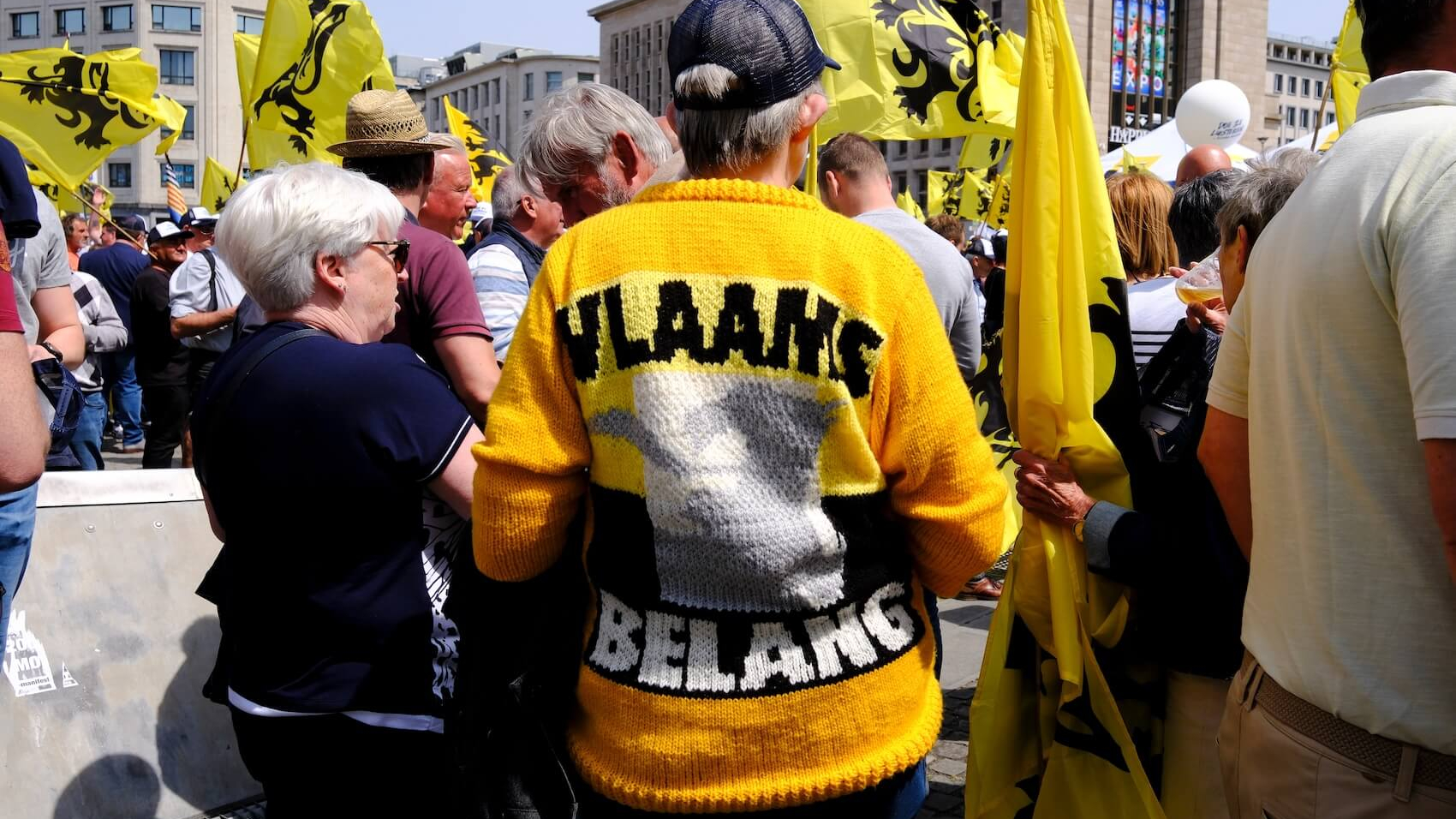
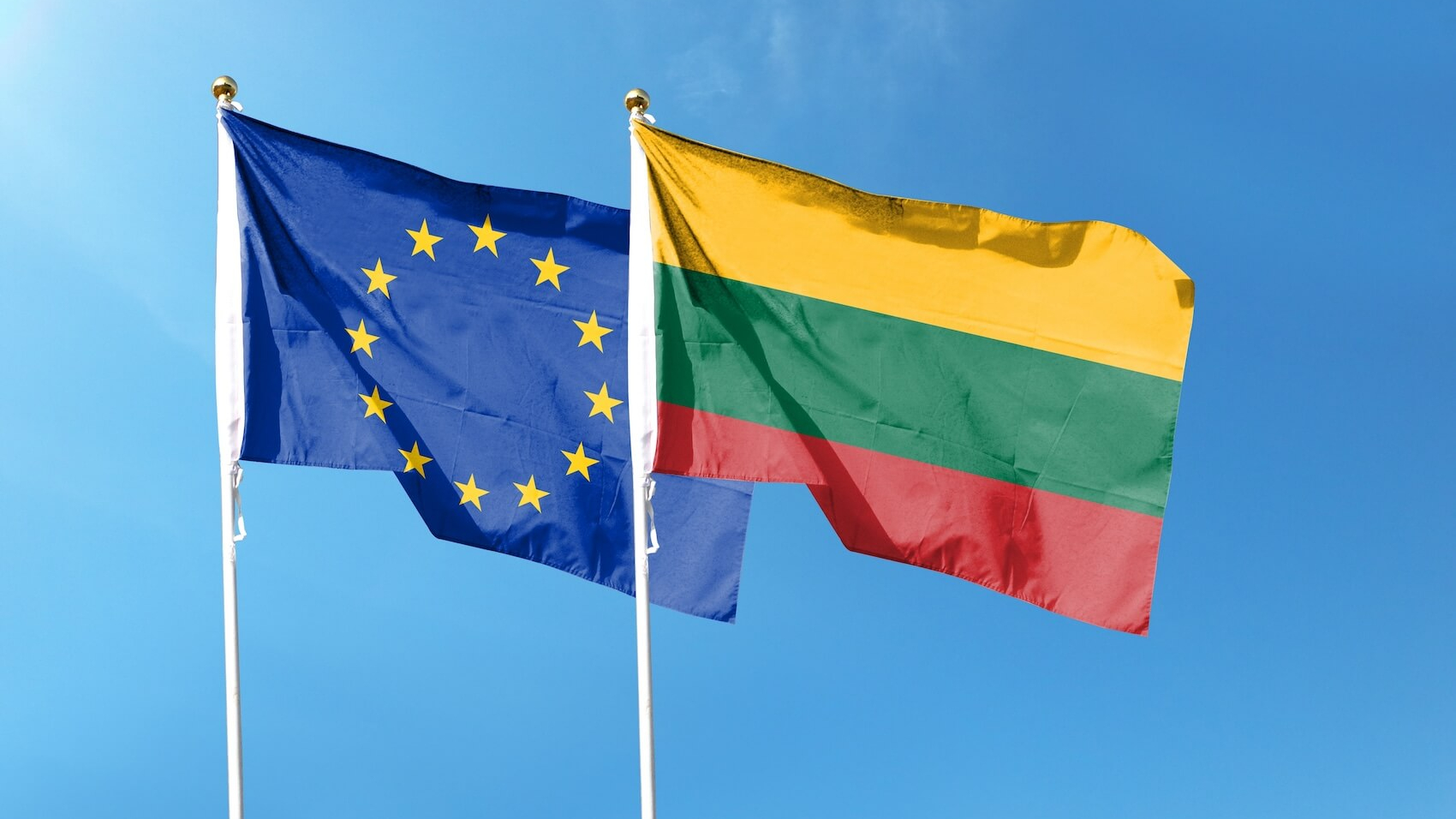
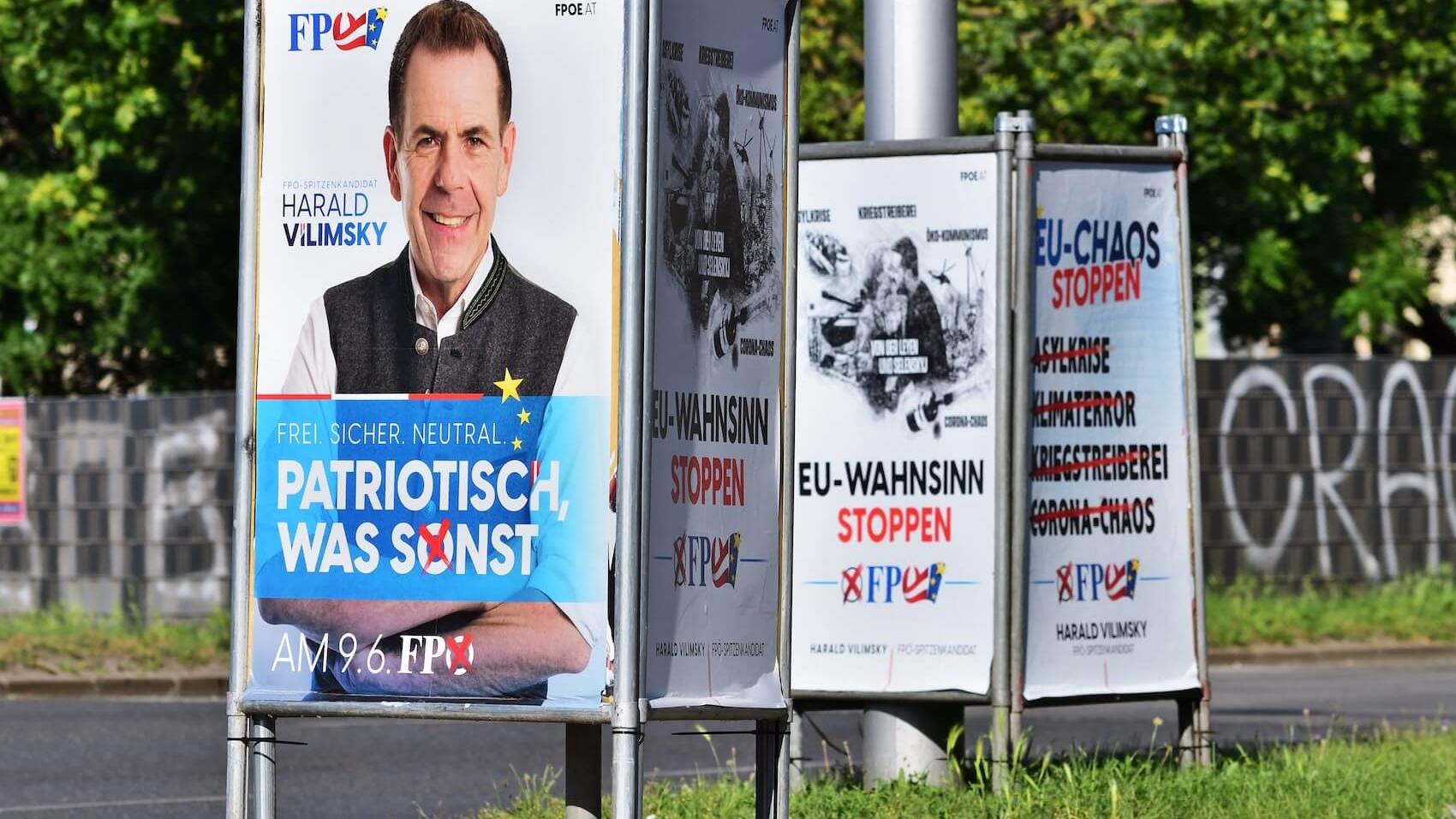
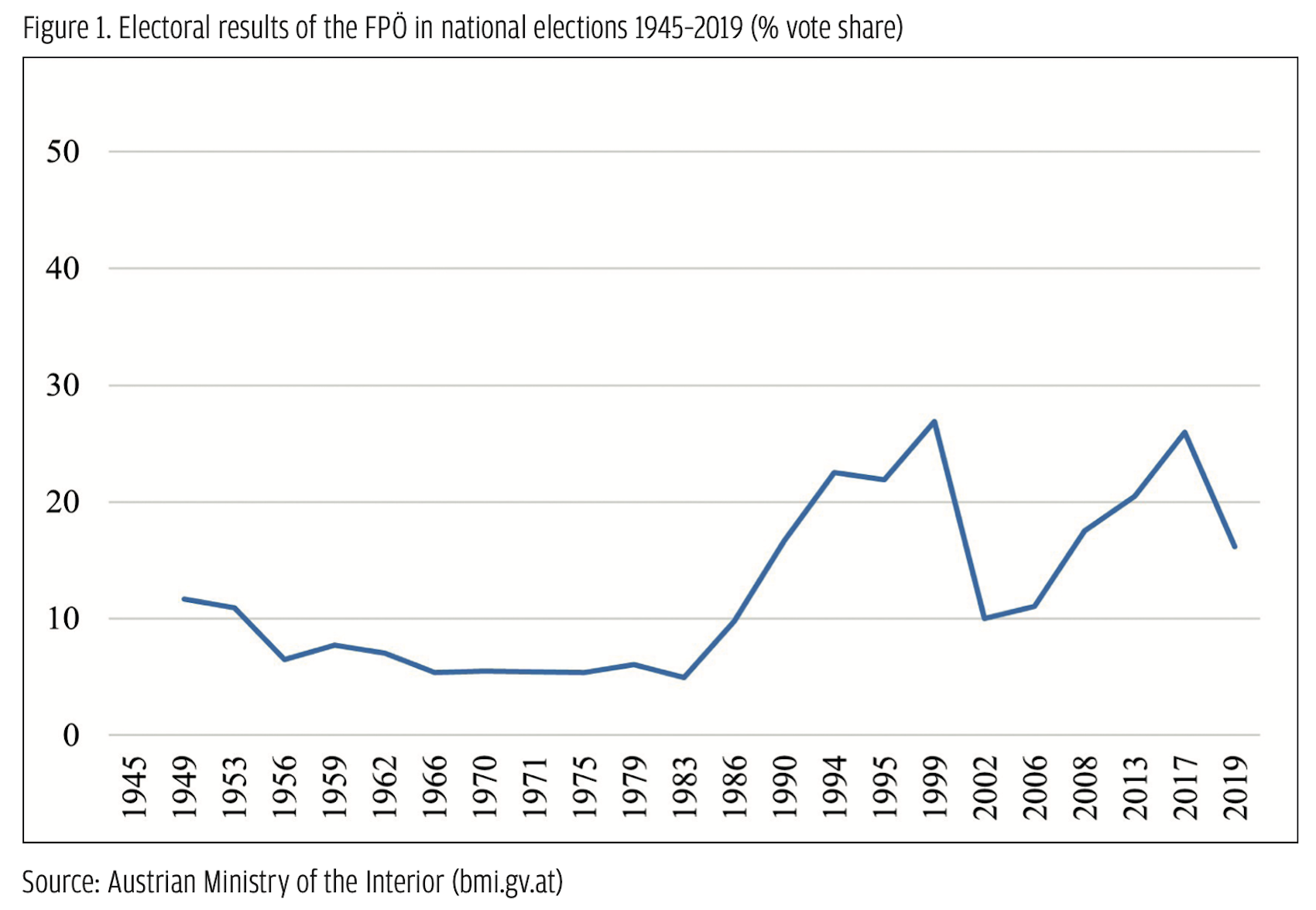 During the 2024 EU elections, the FPÖ was the only populist party represented in the Austrian parliament. The only other party that might be classified as populist that ran in the elections was the Democratic, Neutral, Authentic (DNA) list led by a former physician and anti-vaccine activist, who played an active role in protests directed against the protective measures taken by the Austrian government during the COVID-19 pandemic. This party, however, was founded just months before the elections, received hardly any media- and public attention, and failed to win a seat, taking just 2.7% of the votes. The following report will therefore restrict its focus to the FPÖ.
During the 2024 EU elections, the FPÖ was the only populist party represented in the Austrian parliament. The only other party that might be classified as populist that ran in the elections was the Democratic, Neutral, Authentic (DNA) list led by a former physician and anti-vaccine activist, who played an active role in protests directed against the protective measures taken by the Austrian government during the COVID-19 pandemic. This party, however, was founded just months before the elections, received hardly any media- and public attention, and failed to win a seat, taking just 2.7% of the votes. The following report will therefore restrict its focus to the FPÖ.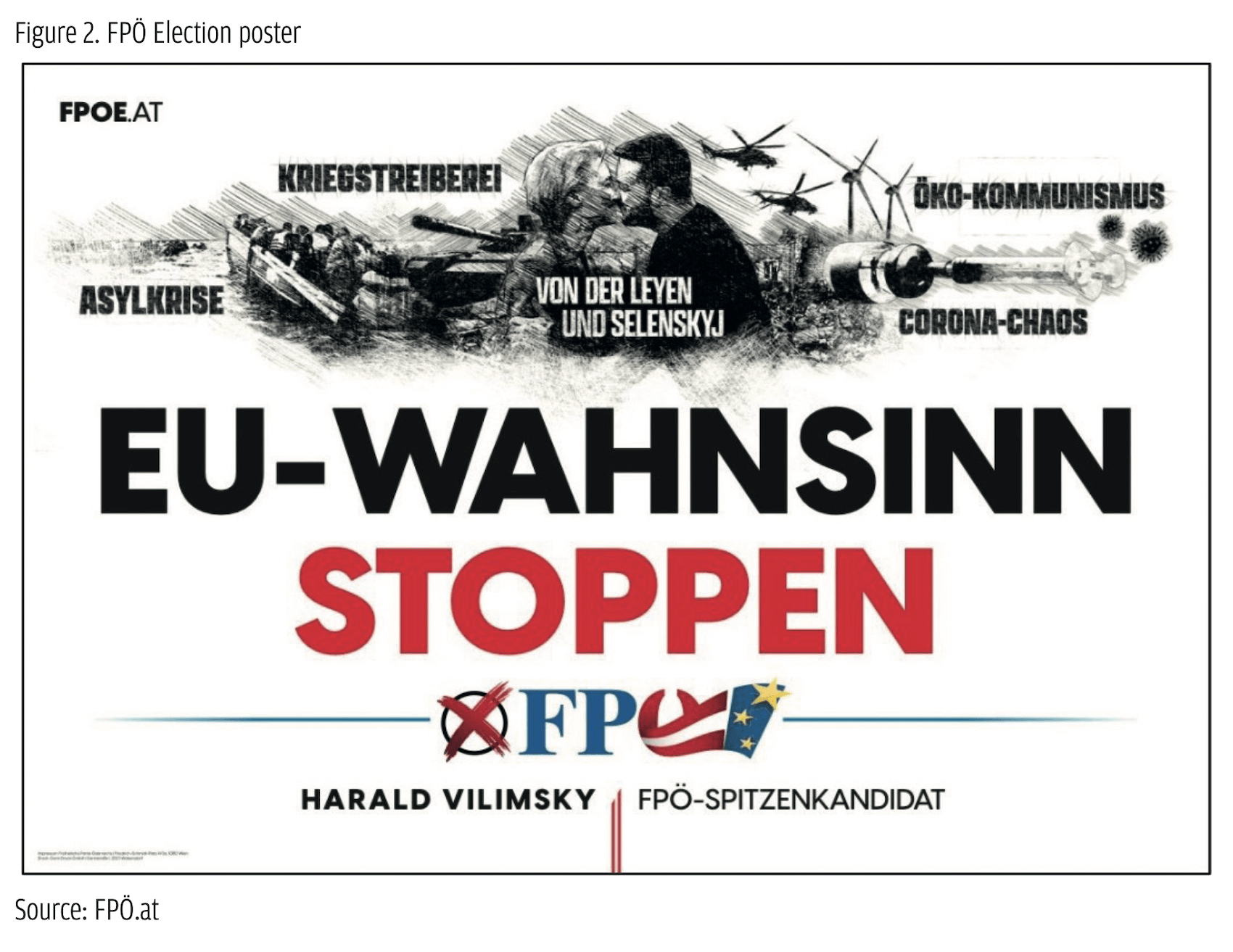 The demand side of the EU: Critical populism in Austria
The demand side of the EU: Critical populism in Austria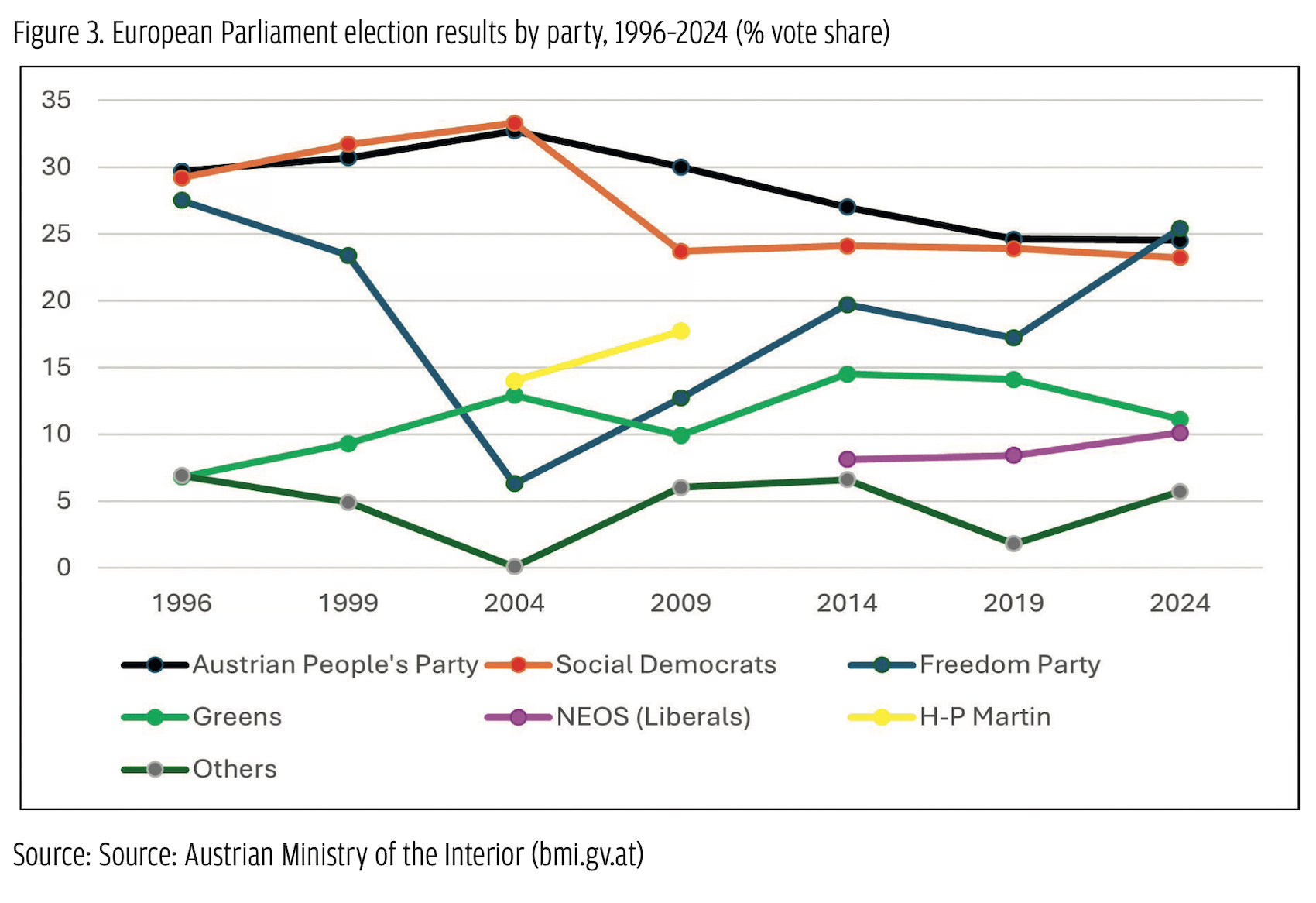 Looking at sociodemographic characteristics (Figure 3), the FPÖ somewhat underperformed amongst voters below the age of 30. Regarding education, it was most successful amongst voters who had completed vocational training and least successful amongst high-school and university graduates. Interestingly, and in line with preceding regional elections (Salzburger Nachrichten, 2024), the once significant gender gap has shrunk considerably compared to the elections in 2019. While back then, 26% of men but only 10% of women voted for the FPÖ, this time it was 27% of men compared to 24% of women. Amongst voters holding at least a college degree, the gap even vanished entirely, with 16% of men and 17% of women opting for the FPÖ (Laumer & Praprotnik, 2024). Amongst others, these changes may be a consequence of the position the party took during the COVID-19 pandemic (especially its critique to discriminate restrictions between vaccinated and non-vaccinated citizens) – which was also found among many (also highly-educated) women (Die Presse, 2021).
Looking at sociodemographic characteristics (Figure 3), the FPÖ somewhat underperformed amongst voters below the age of 30. Regarding education, it was most successful amongst voters who had completed vocational training and least successful amongst high-school and university graduates. Interestingly, and in line with preceding regional elections (Salzburger Nachrichten, 2024), the once significant gender gap has shrunk considerably compared to the elections in 2019. While back then, 26% of men but only 10% of women voted for the FPÖ, this time it was 27% of men compared to 24% of women. Amongst voters holding at least a college degree, the gap even vanished entirely, with 16% of men and 17% of women opting for the FPÖ (Laumer & Praprotnik, 2024). Amongst others, these changes may be a consequence of the position the party took during the COVID-19 pandemic (especially its critique to discriminate restrictions between vaccinated and non-vaccinated citizens) – which was also found among many (also highly-educated) women (Die Presse, 2021).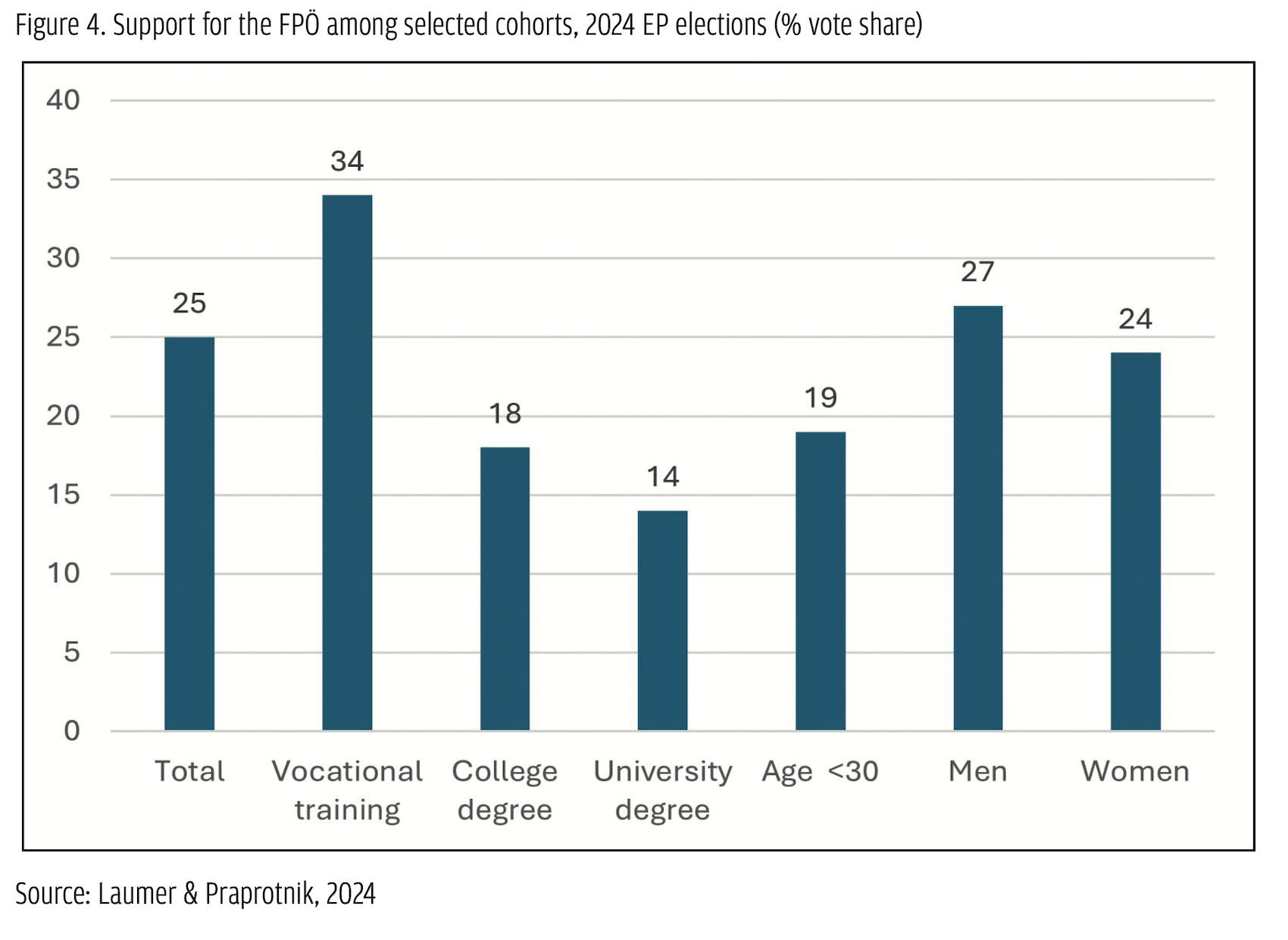 Looking at voters’ issue preferences shows that, generally, there is quite a significant demand for EU-critical positions within the Austrian electorate. While in the 1994 constitutional referendum on the country’s EU accession, a two-thirds majority voted ‘yes’, approval rates started to drop soon thereafter, and Austrian citizens have ranked amongst the most critical ones across the EU ever since (Fallend, 2008). As Figure 5 shows, in the Eurobarometer from autumn 2023 (European Parliament, 2023), Austria not only recorded the highest share of citizens seeing EU membership as a ‘bad thing’ (22%) but also the lowest share of those seeing it as a ‘good thing’ (42%).
Looking at voters’ issue preferences shows that, generally, there is quite a significant demand for EU-critical positions within the Austrian electorate. While in the 1994 constitutional referendum on the country’s EU accession, a two-thirds majority voted ‘yes’, approval rates started to drop soon thereafter, and Austrian citizens have ranked amongst the most critical ones across the EU ever since (Fallend, 2008). As Figure 5 shows, in the Eurobarometer from autumn 2023 (European Parliament, 2023), Austria not only recorded the highest share of citizens seeing EU membership as a ‘bad thing’ (22%) but also the lowest share of those seeing it as a ‘good thing’ (42%). 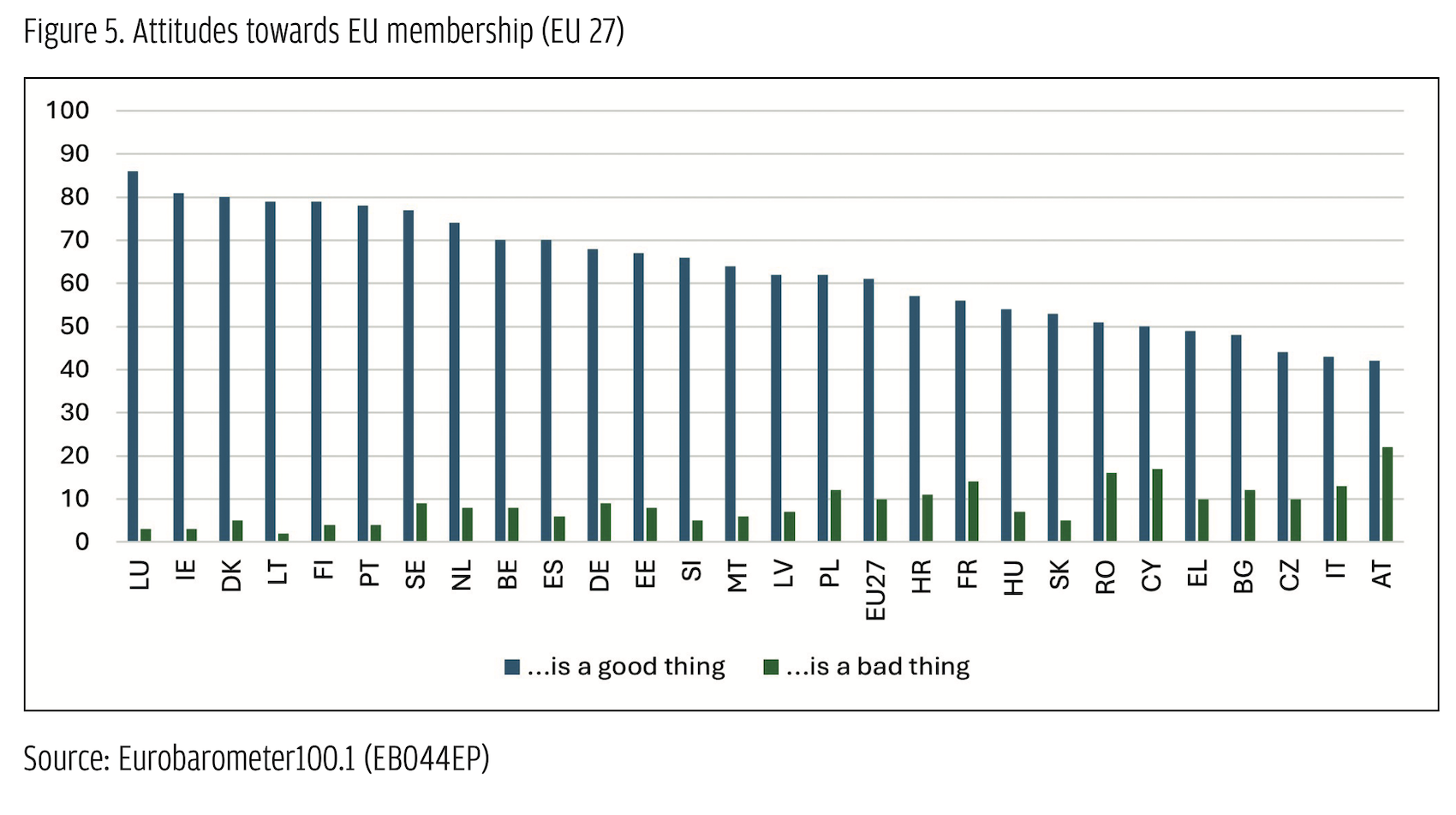 The FPÖ was very successful in attracting these groups. According to exit polls, 84% of its voters see the EU taking a rather negative development and 63% would even support Austria leaving the EU (Figure 6).
The FPÖ was very successful in attracting these groups. According to exit polls, 84% of its voters see the EU taking a rather negative development and 63% would even support Austria leaving the EU (Figure 6).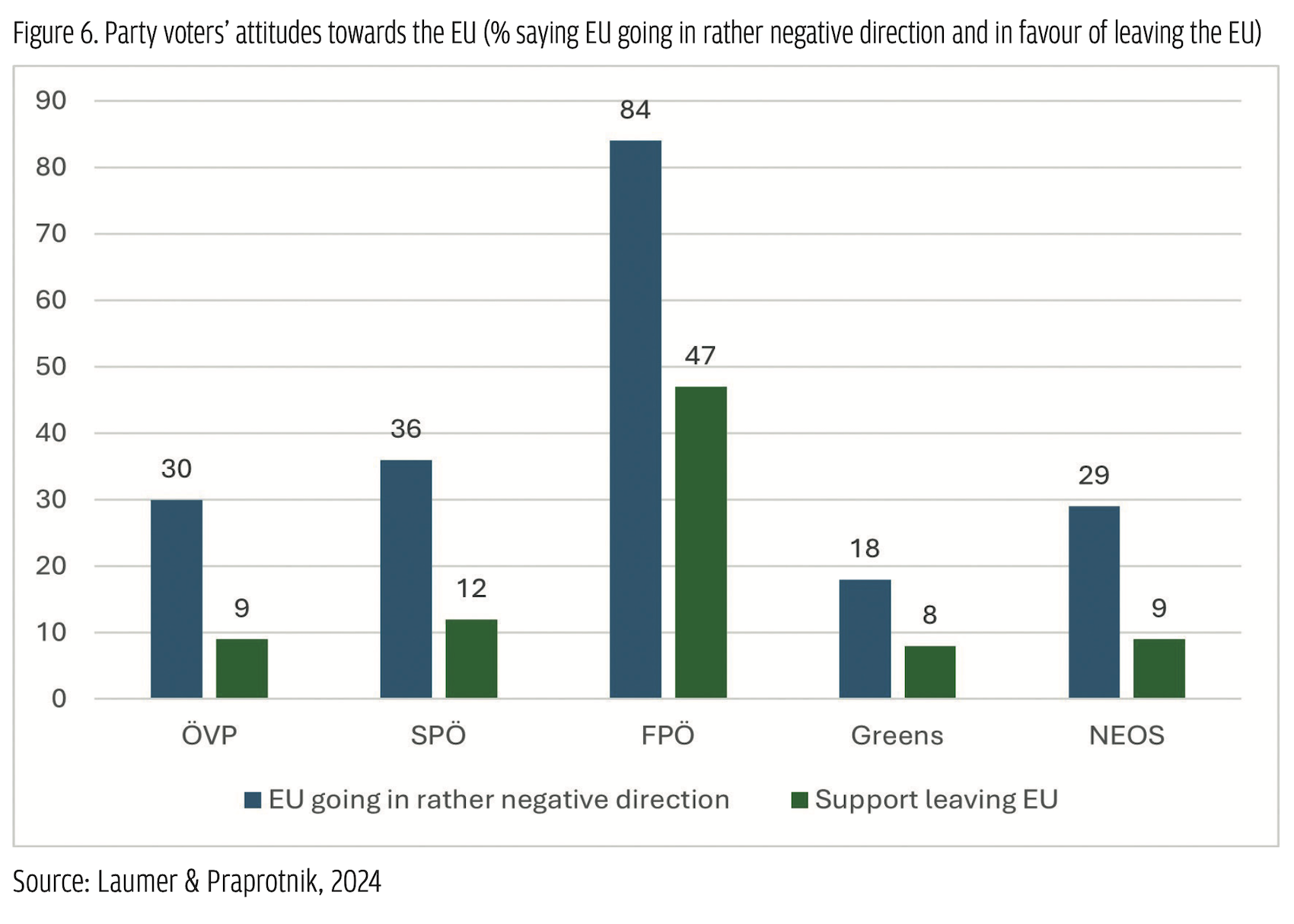 Overall, however, only 4% stated that EU protest was their main reason to vote for the FPÖ, while 40% pointed to the party’s issue positions more generally. Looking at these issues, again, reveals a considerable overlap with the issues the party pushed in its campaign. Among the issues FPÖ voters discussed ‘a lot’ before the elections, ‘migration’ clearly ranks highest (71%), followed by ‘security and war’ (48%), the ‘economy’ (36%), and the ‘Covid pandemic’ (30%), with ‘environment and climate protection’ clearly lagging behind (20%).
Overall, however, only 4% stated that EU protest was their main reason to vote for the FPÖ, while 40% pointed to the party’s issue positions more generally. Looking at these issues, again, reveals a considerable overlap with the issues the party pushed in its campaign. Among the issues FPÖ voters discussed ‘a lot’ before the elections, ‘migration’ clearly ranks highest (71%), followed by ‘security and war’ (48%), the ‘economy’ (36%), and the ‘Covid pandemic’ (30%), with ‘environment and climate protection’ clearly lagging behind (20%).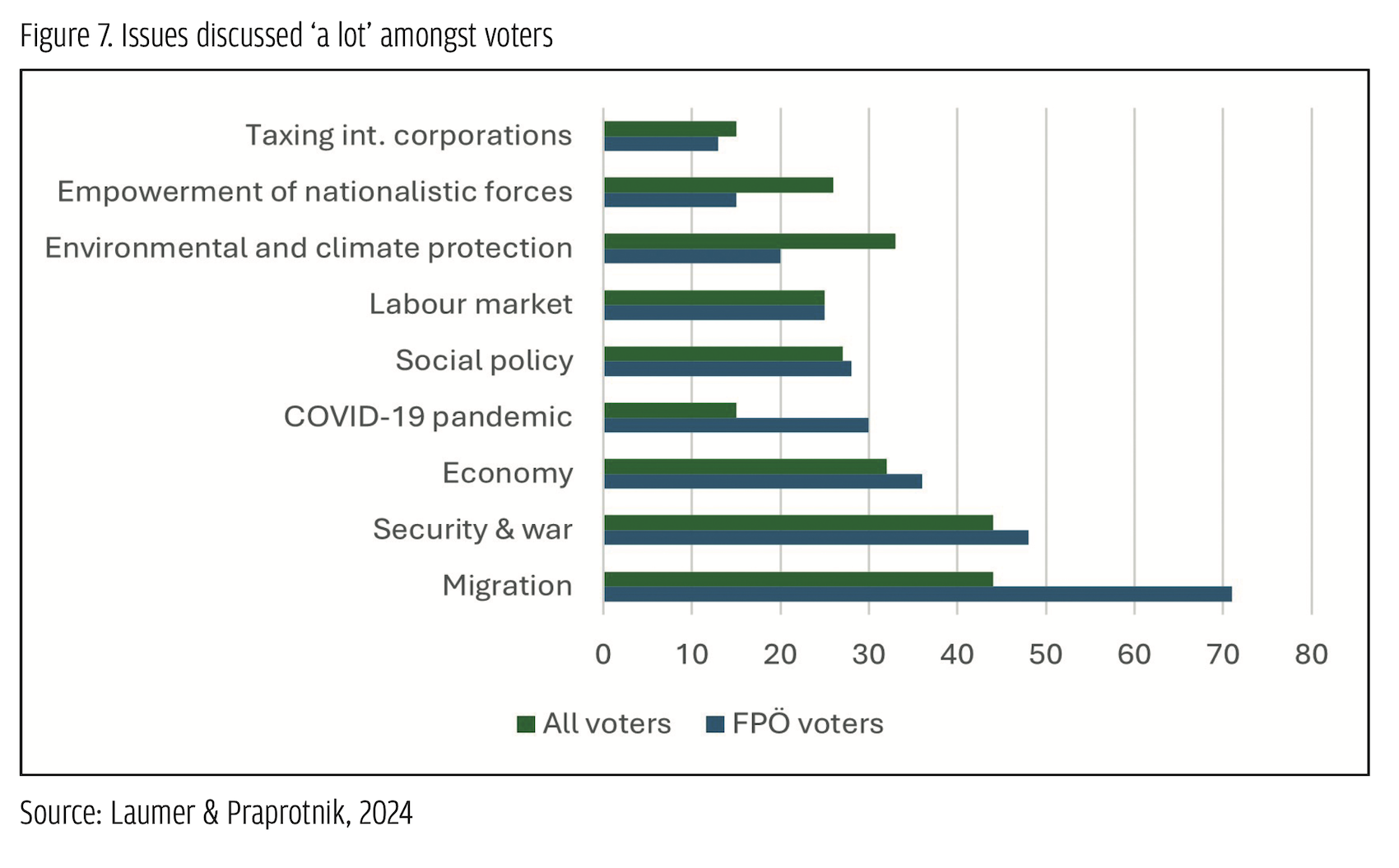 Public attention for the elections overall was relatively modest. About eight weeks before the elections, less than 50% of the Austrian electorate reported knowing the parties’ lead candidates, and even more stated that they could not assess their work (Die Presse, 2024). To the extent that the election was an issue, however, the FPÖ and its core issues featured quite prominently in the debates. In the three TV debates that featured all lead candidates, migration and the war between Russia and Ukraine were discussed for the longest time (followed by the climate crisis). Given the singularity of its positions, the FPÖ was criticized by all other parties quite harshly in all these debates. This criticism resulted in the FPÖ receiving by far the most attention and also allowed the party to (once again) present itself as the only ‘real’ alternative vis-à-vis a purported Einheitspartei (‘single political party’), composed of the ÖVP, the Social Democrats (SPÖ), the Greens and the Liberals. A similar phenomenon can be observed regarding general news coverage where, for example, the election poster discussed above met with extensive criticism by journalists both nationally and internationally, pushing attention to the FPÖ itself and its political demands even further (Hammerl, 2024).
Public attention for the elections overall was relatively modest. About eight weeks before the elections, less than 50% of the Austrian electorate reported knowing the parties’ lead candidates, and even more stated that they could not assess their work (Die Presse, 2024). To the extent that the election was an issue, however, the FPÖ and its core issues featured quite prominently in the debates. In the three TV debates that featured all lead candidates, migration and the war between Russia and Ukraine were discussed for the longest time (followed by the climate crisis). Given the singularity of its positions, the FPÖ was criticized by all other parties quite harshly in all these debates. This criticism resulted in the FPÖ receiving by far the most attention and also allowed the party to (once again) present itself as the only ‘real’ alternative vis-à-vis a purported Einheitspartei (‘single political party’), composed of the ÖVP, the Social Democrats (SPÖ), the Greens and the Liberals. A similar phenomenon can be observed regarding general news coverage where, for example, the election poster discussed above met with extensive criticism by journalists both nationally and internationally, pushing attention to the FPÖ itself and its political demands even further (Hammerl, 2024).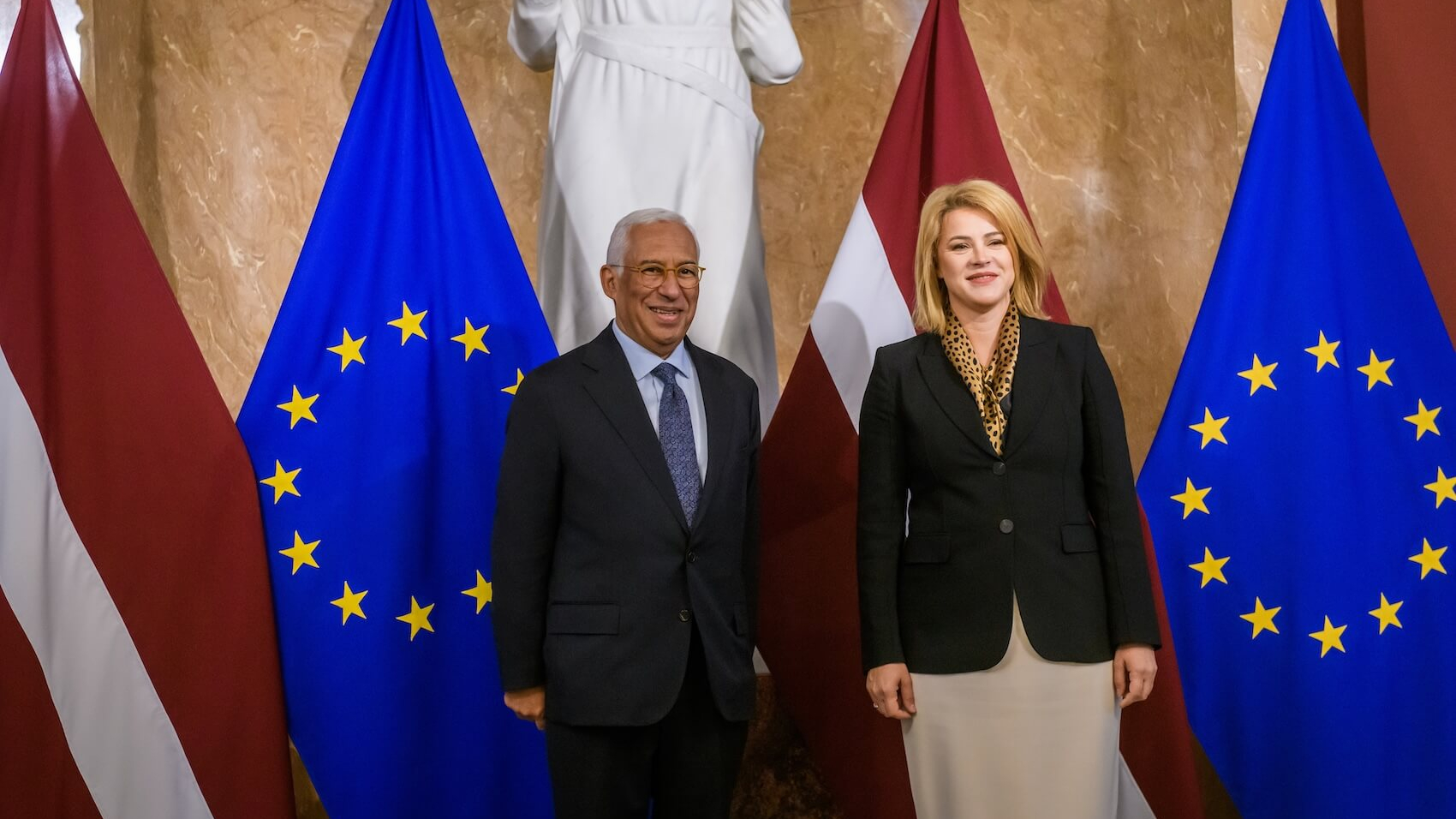

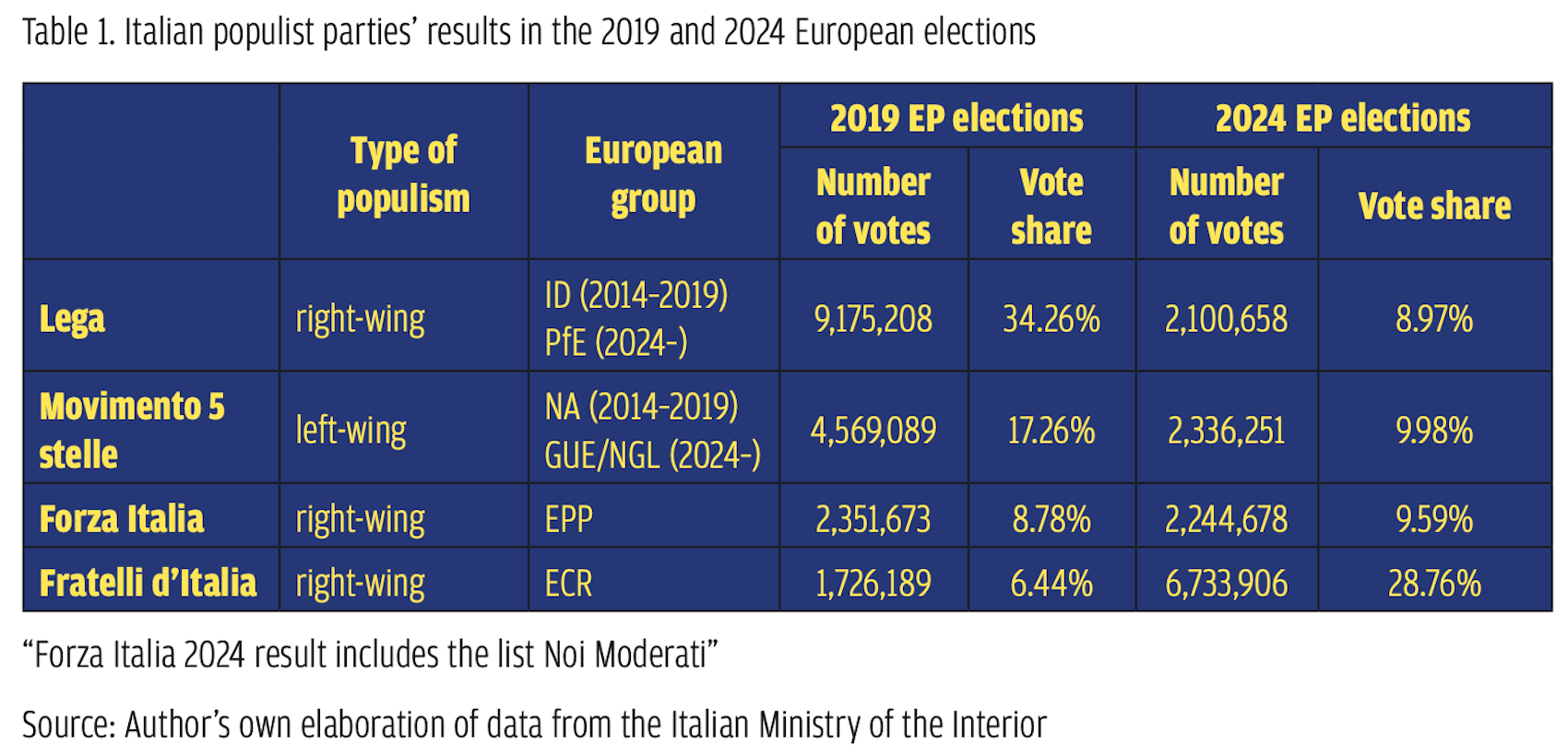

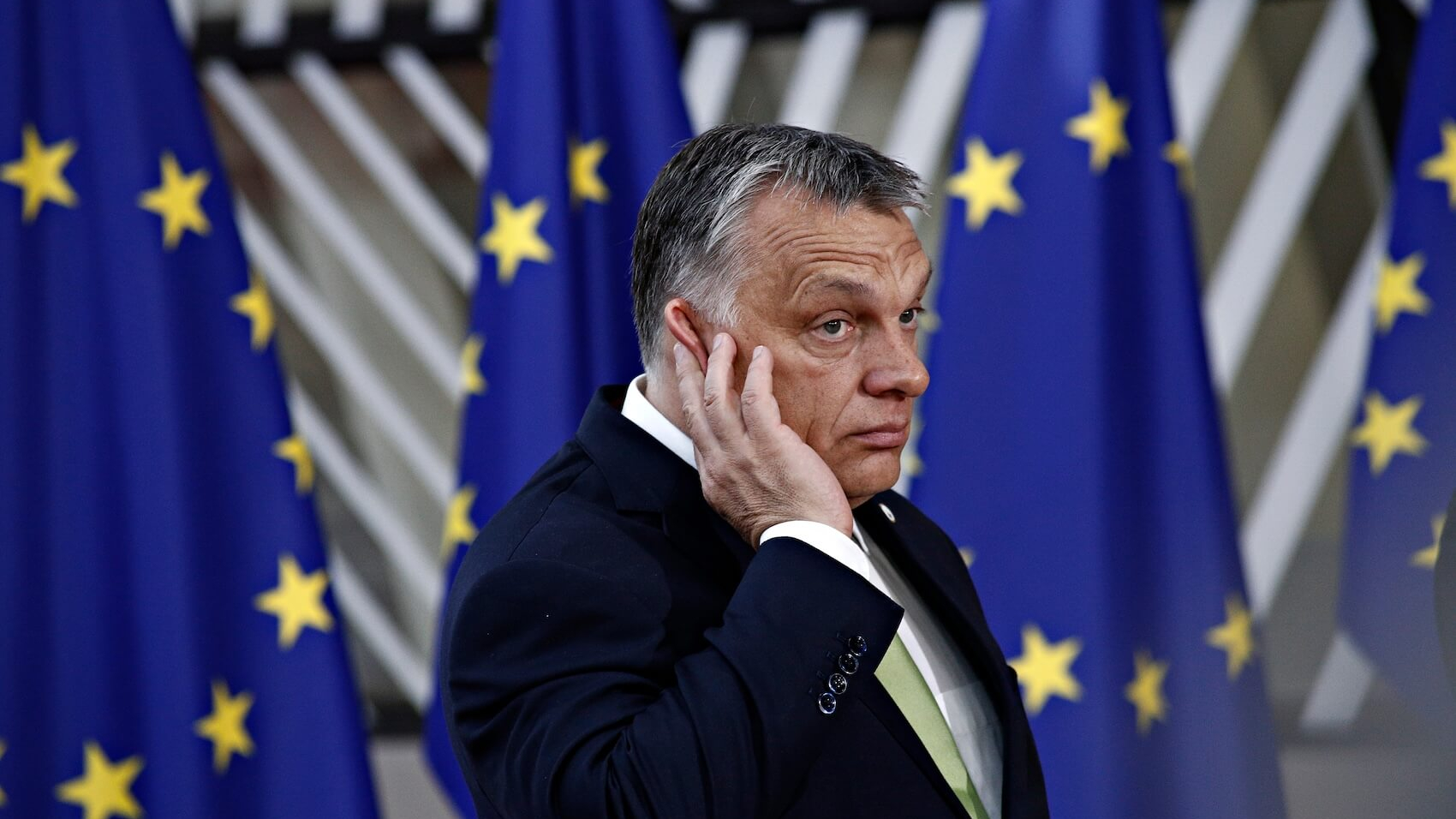
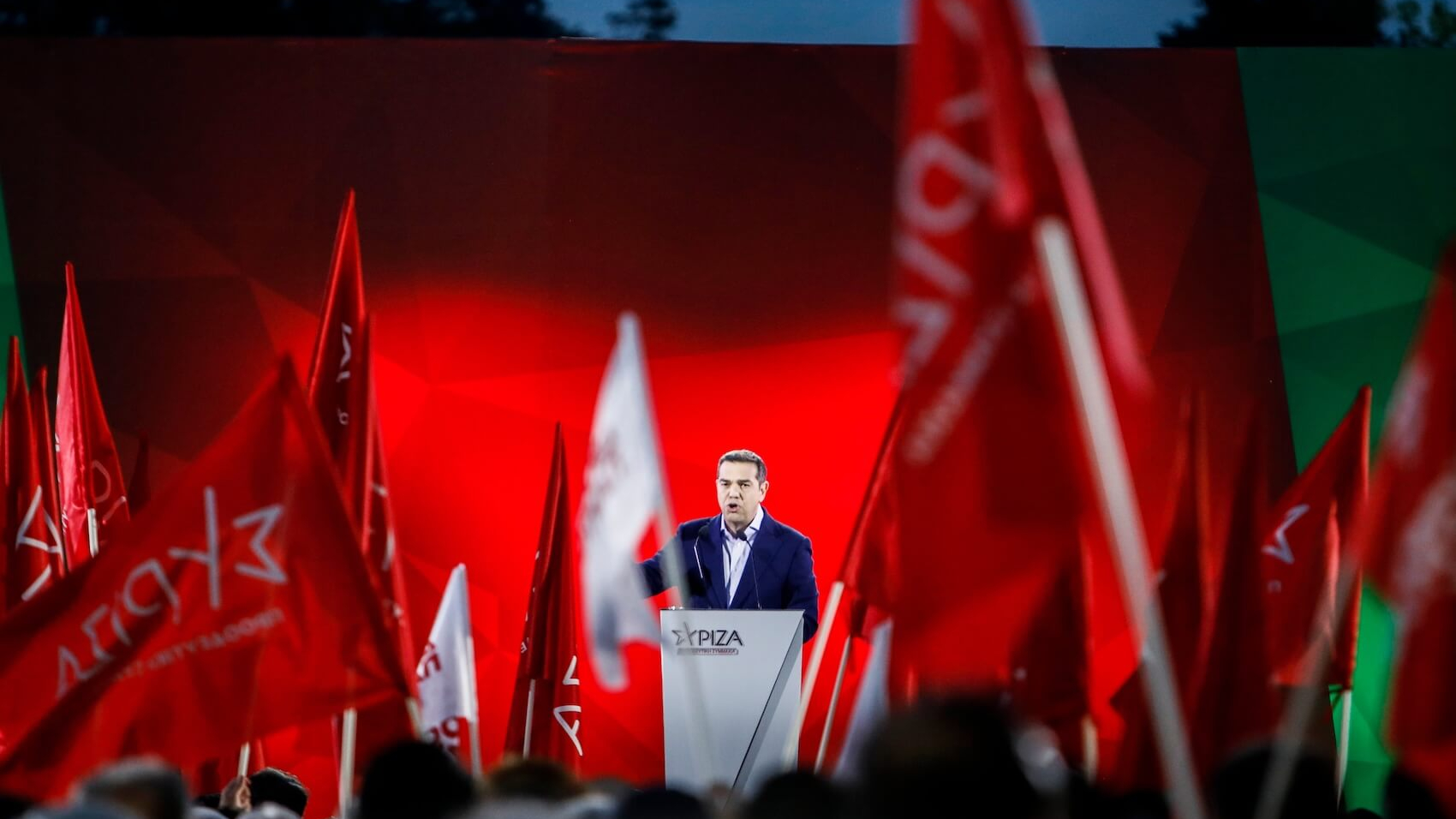
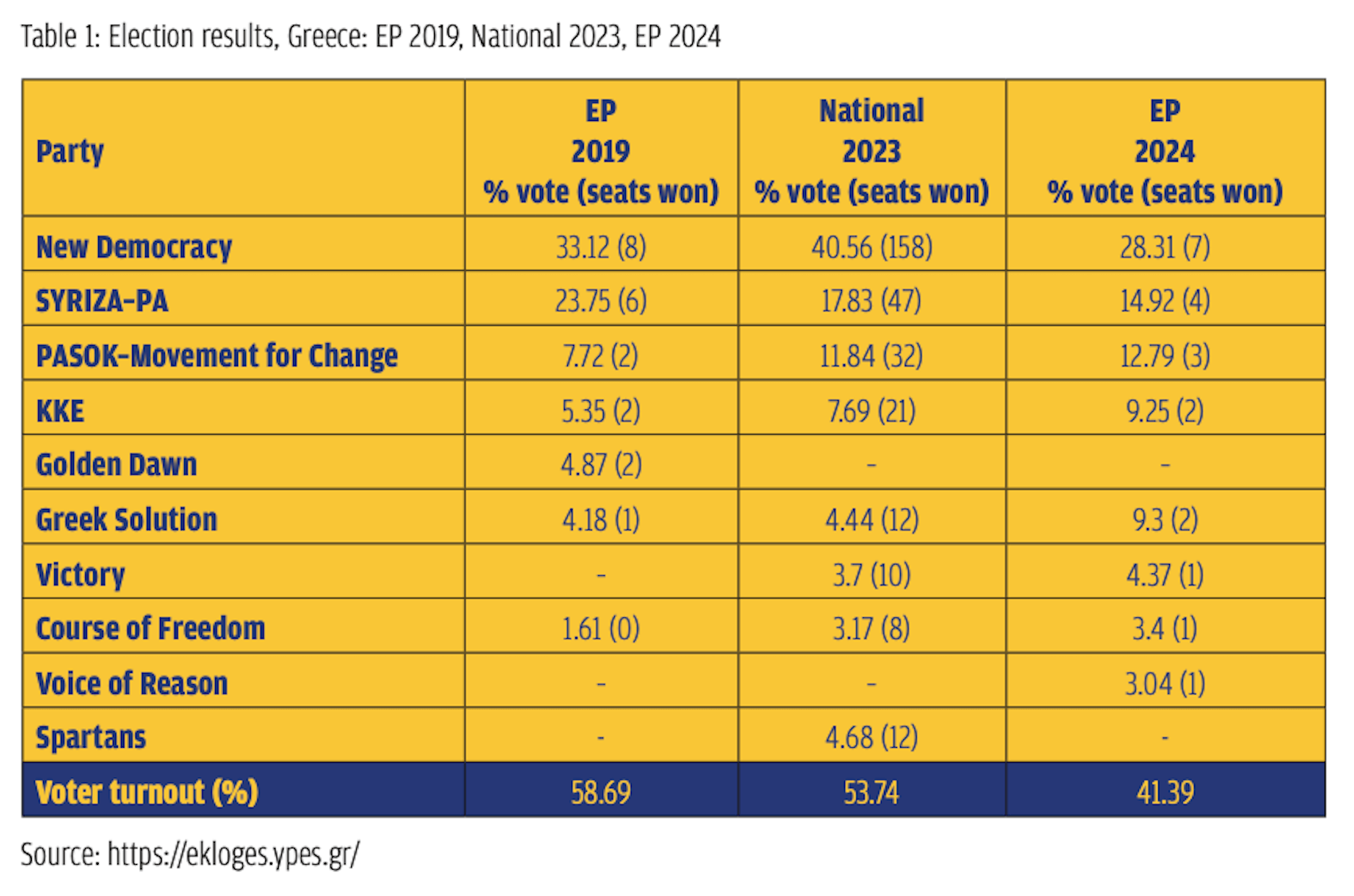
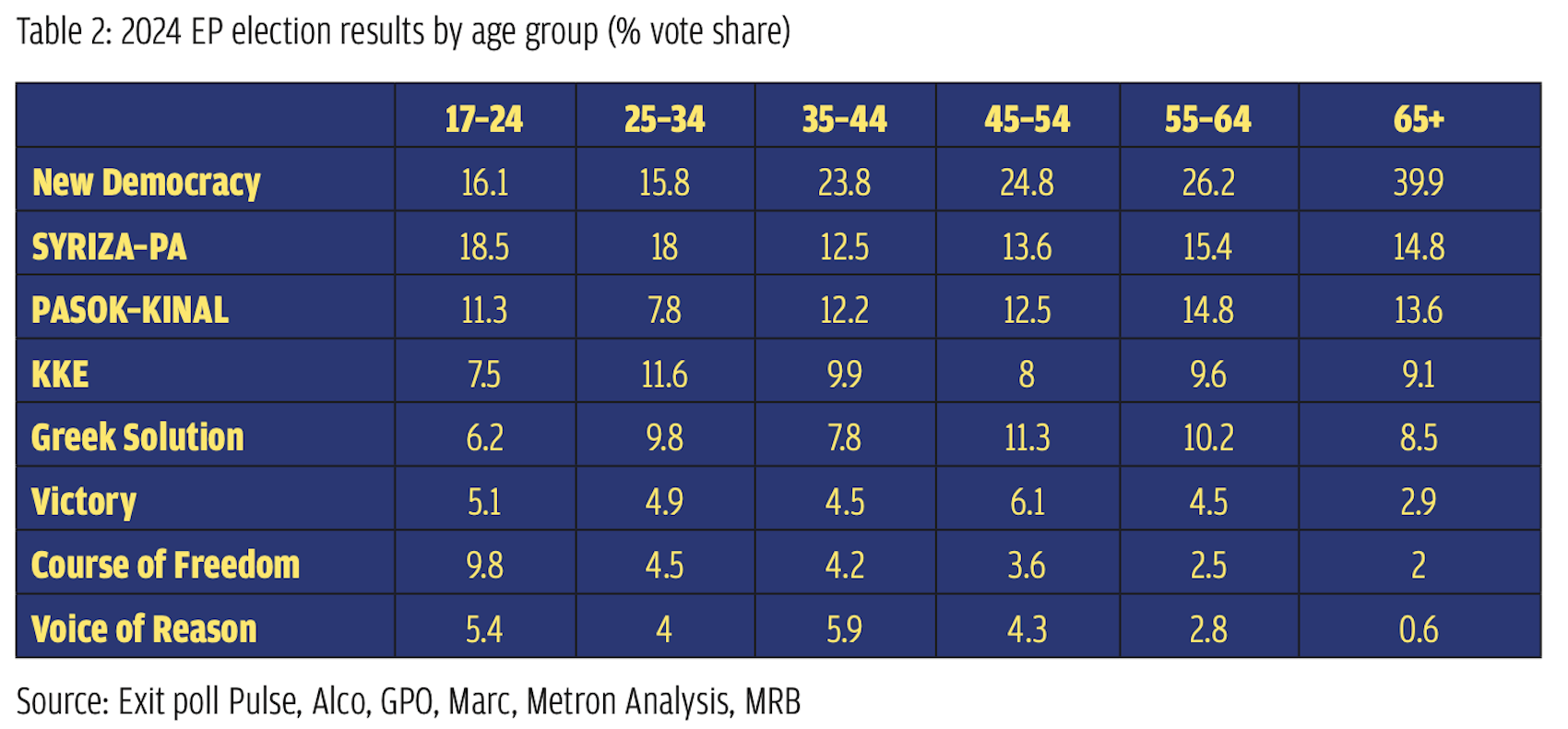
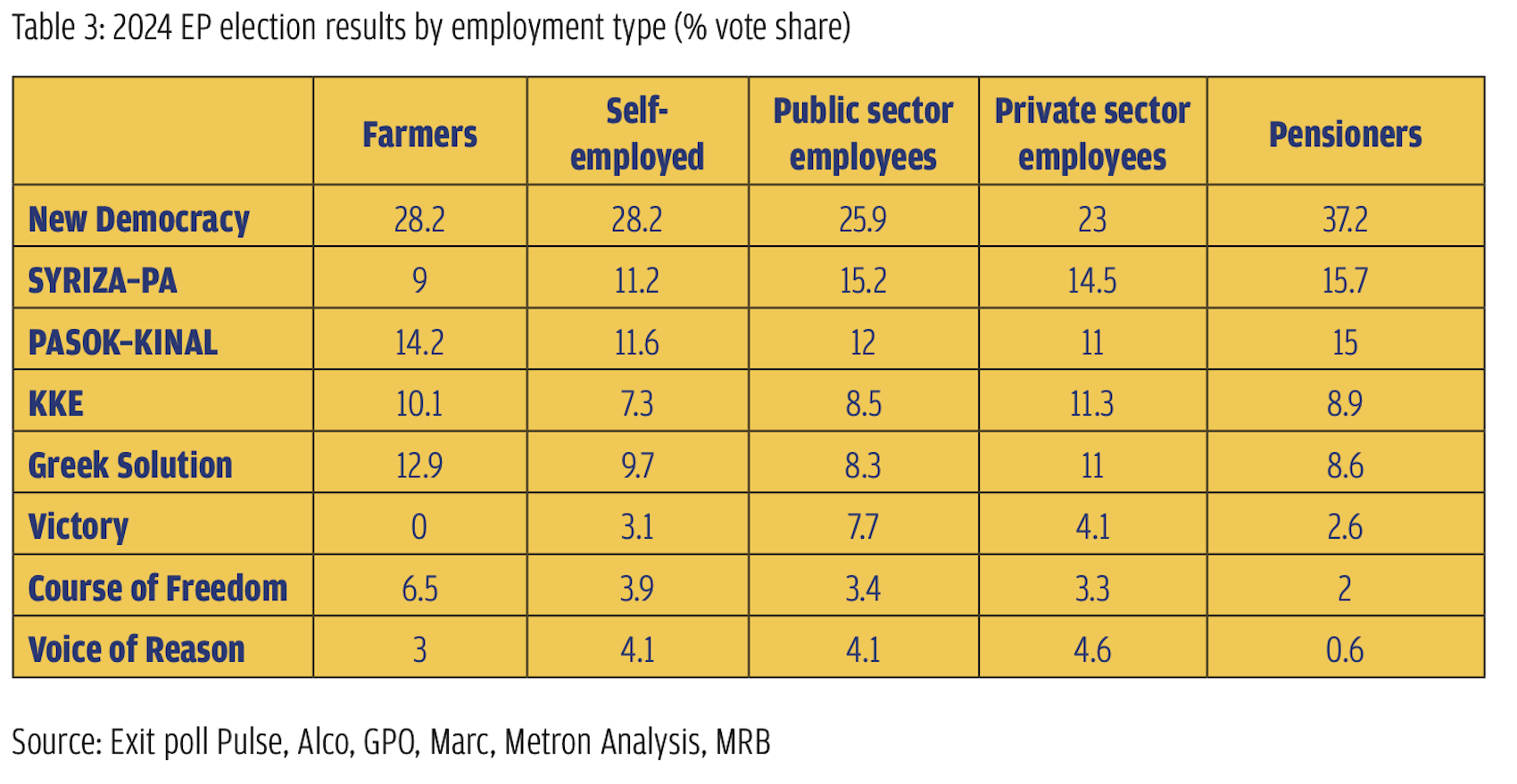 There is also an interesting geographic dimension to the far-right populist vote (for a European perspective, see also Ejrnæs et al., 2024). In many districts in Northern Greece, these parties received above-average results. Specifically, Greek Solution came second in six electoral districts of the north, including Imathia (18.42%), Pella (17.28%), Kilkis (16.54%), Thessaloniki B (15.82%), Serres (15.64%), and Drama (15.52%).
There is also an interesting geographic dimension to the far-right populist vote (for a European perspective, see also Ejrnæs et al., 2024). In many districts in Northern Greece, these parties received above-average results. Specifically, Greek Solution came second in six electoral districts of the north, including Imathia (18.42%), Pella (17.28%), Kilkis (16.54%), Thessaloniki B (15.82%), Serres (15.64%), and Drama (15.52%).